

February 27, 2023
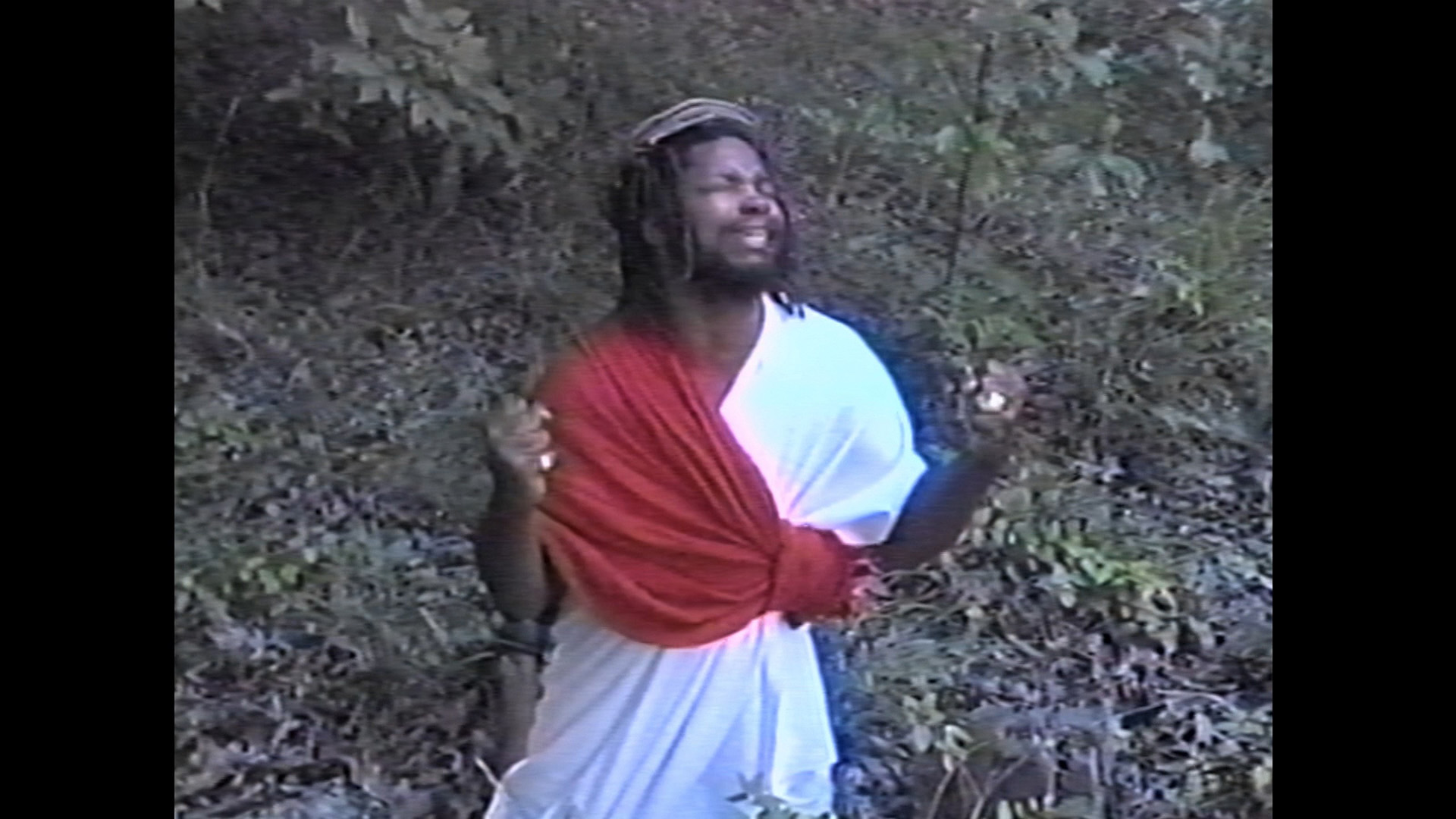 fanzine and VHS culture in the mid-'90s, you could stumble across some really baffling shot-on-video items that simply refused to slip into a single genre. Case in point: Damselvis, Daughter of Helvis, a 1994 freak-out from John Michael McCarthy: Memphis-based underground comic artist, onetime Donald Farmer associate, director of films
fanzine and VHS culture in the mid-'90s, you could stumble across some really baffling shot-on-video items that simply refused to slip into a single genre. Case in point: Damselvis, Daughter of Helvis, a 1994 freak-out from John Michael McCarthy: Memphis-based underground comic artist, onetime Donald Farmer associate, director of films 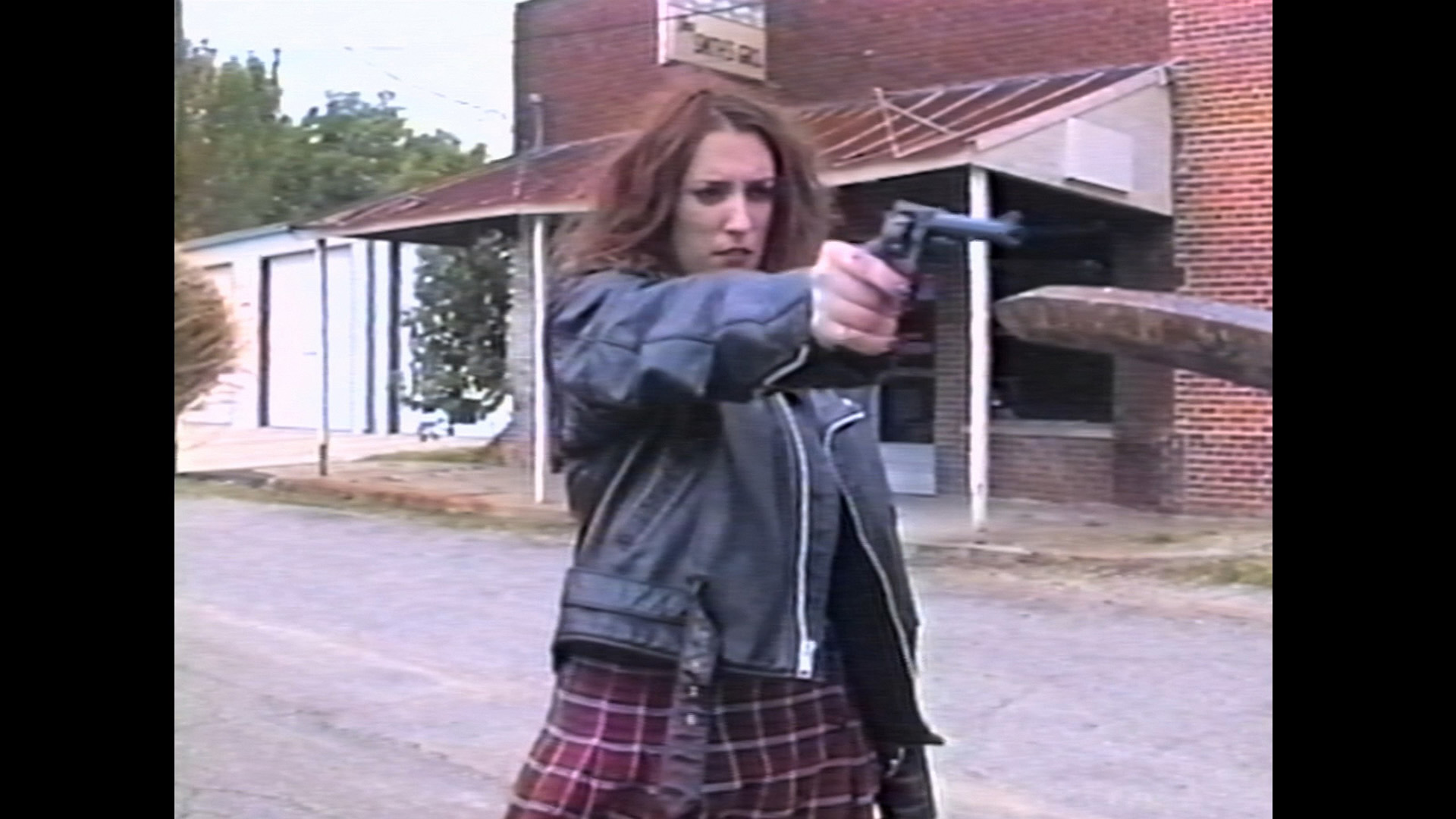 like The Sore Losers and Teenage Tupelo, and the guy who uncovered Bat Pussy. Mentioned far more often than it was actually seen thanks to a marginal self-distributed tape release, this outrageous oddity gets its first bona fide disc release from Saturn's Core Audio & Video in all its lo-fi, fuzzy VHS glory with a whole buncha extras. Based on one of the director's comics, the "plot" packs a lot of strangeness into just over one hour starting with a pre-credits cult session in "The Last Days, October, 1992," led by Black Jesus overseeing his violent gang of biker followers. He's determined to stop the mission of pagan power figure and motorcycle aficionado Damselvis, destined to be reborn through country bumpkin schoolgirl Isla (Sherry Lynn Garris), for a mission to revive her rock 'n' roll god dad, Helvis. Journeys through deserted towns and copious female nudity ensue on the way to a showdown between the Helvis family and... well, you'll just have to see for yourself. The 62-minute film comes with a brisk commentary by McCarthy and Mike Hunchback pointing out how everyone (including lots of non-actors) got cast, what they crew had to do to get by with a microscopic budget, and connections to several of his later productions. An insane collection of making-of footage, clocking in at 187m38s, seems to cover pretty much the entire production in great detail, showing how the makeup and on-location shooting were accomplished virtually in real time. "Resurrecting Helvis" (19m27s) features McCarthy talking about the conception of the story and main character, the inspiration of a pivotal photo of Brigitte Bardot, the only copy of the film in his possession, and some conceptual drawings he made. "Helvis on Tour" (40m18s) is a camcorder-shot collection of nine songs performed live by the cast at Memphis' Atenna Club, followed by a 29m54s presentation of McCarthy reading from the Damselvis and SuperSexxx comic books. Also included are a still gallery (20m24s) and bonus trailers for Sixteen Tongues, Red Spirit Lake, The Good Book, No Resistance, and Mail Order Murder. Buy here or here.
like The Sore Losers and Teenage Tupelo, and the guy who uncovered Bat Pussy. Mentioned far more often than it was actually seen thanks to a marginal self-distributed tape release, this outrageous oddity gets its first bona fide disc release from Saturn's Core Audio & Video in all its lo-fi, fuzzy VHS glory with a whole buncha extras. Based on one of the director's comics, the "plot" packs a lot of strangeness into just over one hour starting with a pre-credits cult session in "The Last Days, October, 1992," led by Black Jesus overseeing his violent gang of biker followers. He's determined to stop the mission of pagan power figure and motorcycle aficionado Damselvis, destined to be reborn through country bumpkin schoolgirl Isla (Sherry Lynn Garris), for a mission to revive her rock 'n' roll god dad, Helvis. Journeys through deserted towns and copious female nudity ensue on the way to a showdown between the Helvis family and... well, you'll just have to see for yourself. The 62-minute film comes with a brisk commentary by McCarthy and Mike Hunchback pointing out how everyone (including lots of non-actors) got cast, what they crew had to do to get by with a microscopic budget, and connections to several of his later productions. An insane collection of making-of footage, clocking in at 187m38s, seems to cover pretty much the entire production in great detail, showing how the makeup and on-location shooting were accomplished virtually in real time. "Resurrecting Helvis" (19m27s) features McCarthy talking about the conception of the story and main character, the inspiration of a pivotal photo of Brigitte Bardot, the only copy of the film in his possession, and some conceptual drawings he made. "Helvis on Tour" (40m18s) is a camcorder-shot collection of nine songs performed live by the cast at Memphis' Atenna Club, followed by a 29m54s presentation of McCarthy reading from the Damselvis and SuperSexxx comic books. Also included are a still gallery (20m24s) and bonus trailers for Sixteen Tongues, Red Spirit Lake, The Good Book, No Resistance, and Mail Order Murder. Buy here or here. 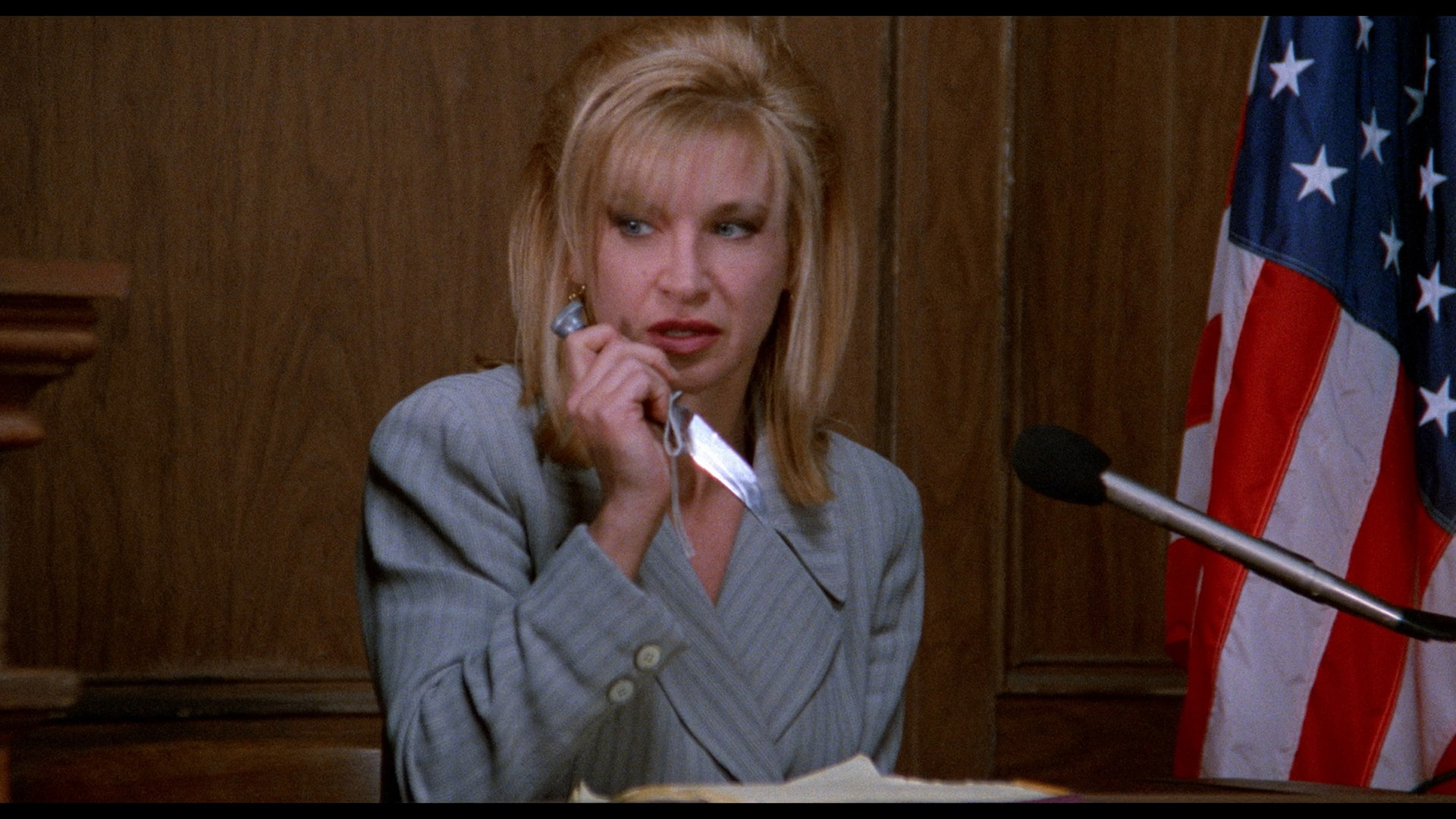 are still a lot of key films left to go, that streak continues from Vinegar Syndrome's VSA line with Sworn to Justice, a satisfying 1996 revenge film with plenty of feisty combat scenes. The film starts strong out of the gate with criminal
are still a lot of key films left to go, that streak continues from Vinegar Syndrome's VSA line with Sworn to Justice, a satisfying 1996 revenge film with plenty of feisty combat scenes. The film starts strong out of the gate with criminal 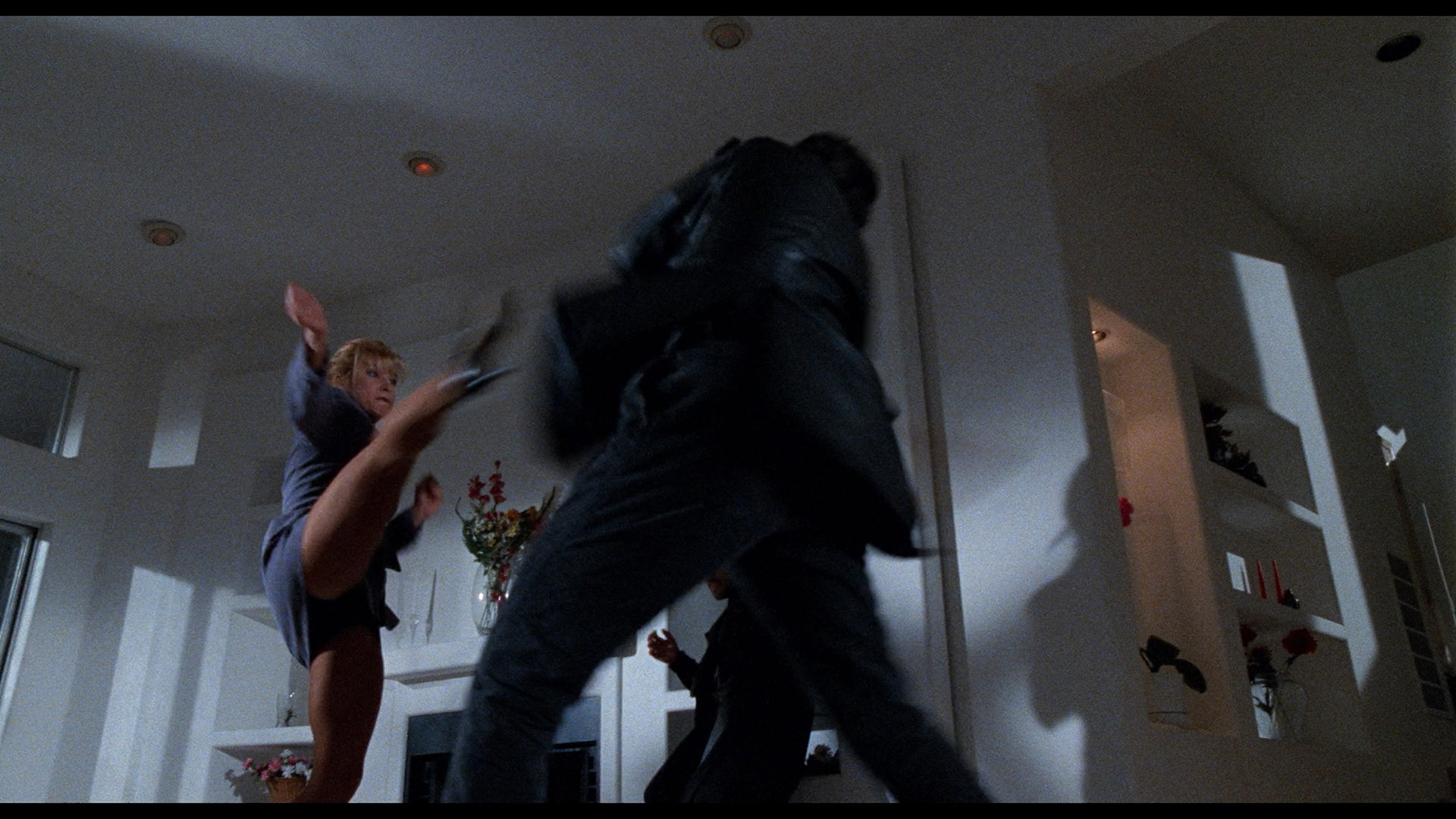 psychologist Janna Dane (Rothrock) coming home late one night to find her young sister and nephew murdered by home intruders who try to kill her as well. She fights back hard and manages to escape, but a plunge three stories down to the bushes leaves her with a psychic ability while she's clutching a family locket. Normally involved in defending criminals in court, she decides to change her tune after a twist of fate involving one of the perps and embarks on a crusade to bring justice once and for all. Complete with that unmistakable ambient electronic music approach you heard all the time around '96, not to mention a great cast of supporting names (Mako, Tony LoBianco, Brad Dourif, and Walter Koenig), this is a prime slice of indie American action fun that looks infinitely better here on Blu-ray compared to earlier releases (including a MTI DVD from 2001) with a fresh 4K restoration from the 35mm camera negative that stomps all over many big studio catalog releases. In the new featurette "Romancing the Rothrock" (14m47s), a cheerful Rothrock looks back at working as an associate producer on the film, her trepidation about doing a love scene with co-star Kurt McKinney spicier than her usual fare, the jargon she had to learn for her role, and the window-jumping shot that found a new life through Jay Leno. Director, producer, and co-writer Paul Maslak turns up in "Kung Fu Directing" (24m8s) to talk about his own entry into martial arts and his friendship with Rothrock extending quite a while before this film, and you also get archival interviews with Rothrock from 2017 (3m57s), Maslak (10m44s), producer Neva Friedenn (7m39s), and very lively actor and second unit director Art Camacho (5m26s), plus an archival 22m52s making-of EPK doc, a video trailer, and a promo trailer under the alternate title Blonde Justice. Buy here or here.
psychologist Janna Dane (Rothrock) coming home late one night to find her young sister and nephew murdered by home intruders who try to kill her as well. She fights back hard and manages to escape, but a plunge three stories down to the bushes leaves her with a psychic ability while she's clutching a family locket. Normally involved in defending criminals in court, she decides to change her tune after a twist of fate involving one of the perps and embarks on a crusade to bring justice once and for all. Complete with that unmistakable ambient electronic music approach you heard all the time around '96, not to mention a great cast of supporting names (Mako, Tony LoBianco, Brad Dourif, and Walter Koenig), this is a prime slice of indie American action fun that looks infinitely better here on Blu-ray compared to earlier releases (including a MTI DVD from 2001) with a fresh 4K restoration from the 35mm camera negative that stomps all over many big studio catalog releases. In the new featurette "Romancing the Rothrock" (14m47s), a cheerful Rothrock looks back at working as an associate producer on the film, her trepidation about doing a love scene with co-star Kurt McKinney spicier than her usual fare, the jargon she had to learn for her role, and the window-jumping shot that found a new life through Jay Leno. Director, producer, and co-writer Paul Maslak turns up in "Kung Fu Directing" (24m8s) to talk about his own entry into martial arts and his friendship with Rothrock extending quite a while before this film, and you also get archival interviews with Rothrock from 2017 (3m57s), Maslak (10m44s), producer Neva Friedenn (7m39s), and very lively actor and second unit director Art Camacho (5m26s), plus an archival 22m52s making-of EPK doc, a video trailer, and a promo trailer under the alternate title Blonde Justice. Buy here or here. 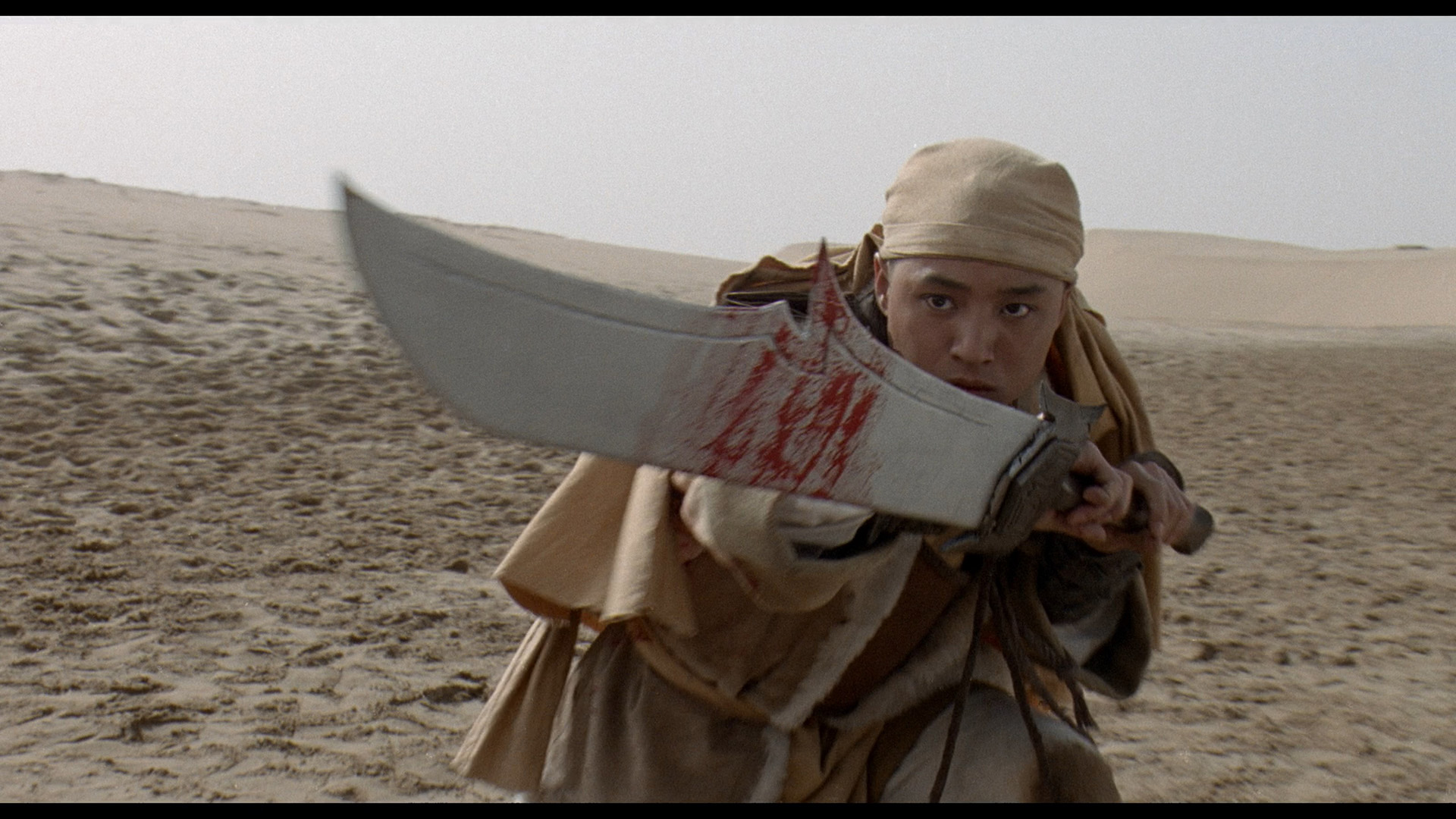 Burning Paradise, an ambitious Qing dynasty action epic with horror overtones that proved to be a big box office misfire at the time. Since then the film has gained something of a cult reputation for its genre-fusing attitude and lavish visuals,
Burning Paradise, an ambitious Qing dynasty action epic with horror overtones that proved to be a big box office misfire at the time. Since then the film has gained something of a cult reputation for its genre-fusing attitude and lavish visuals, 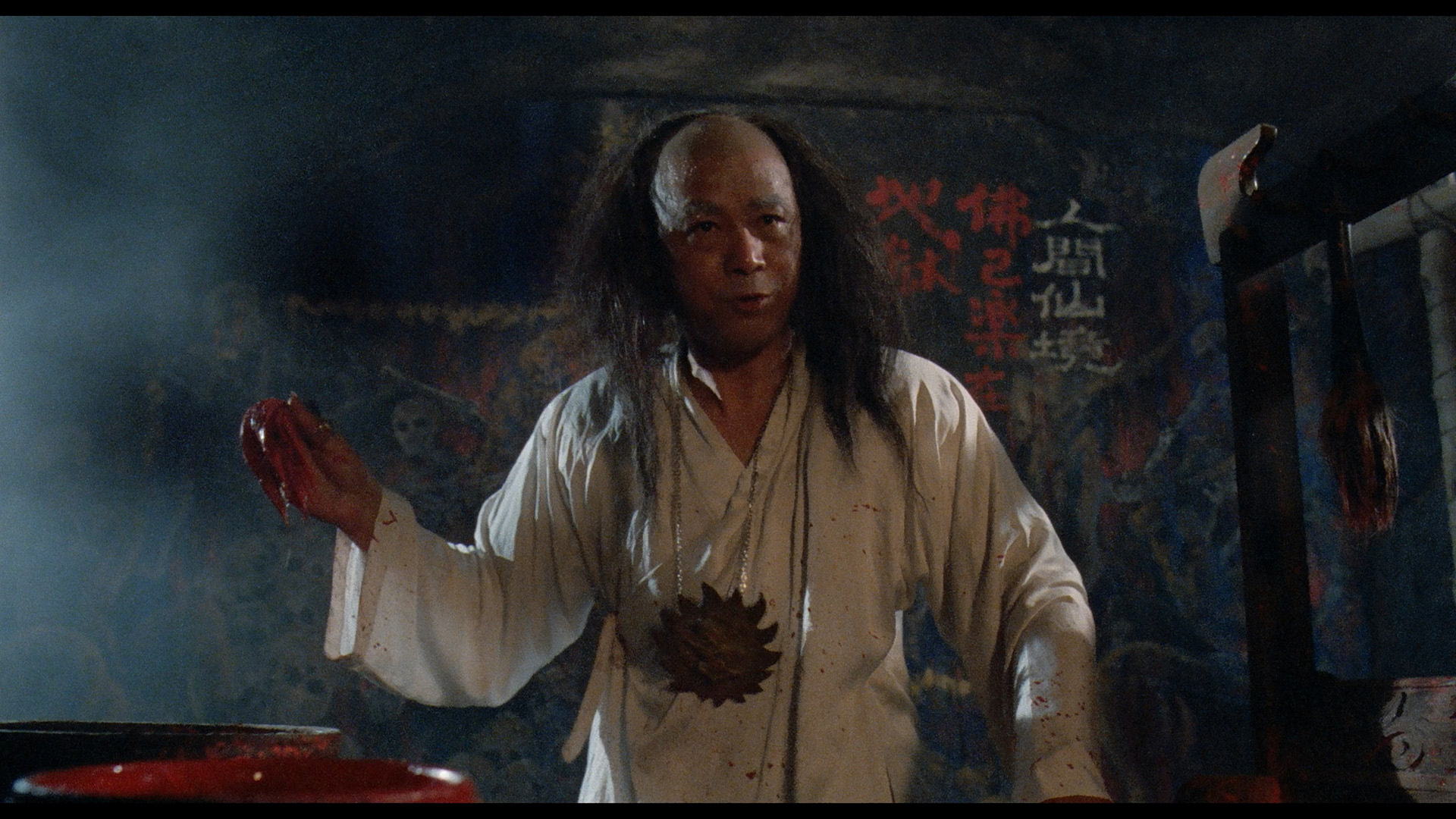 both of which are easy to appreciate on the Vinegar Syndrome Blu-ray release from 2022. Targeted for their rebellious spirit, a Shaolin Temple's monks are killed and imprisoned by the government during a major purge. Held captive in a nightmarish prison by a mad general who creates art with human plasma, the disciples prove to possess skills more formidable than their oppressors had imagined -- which results in an elaborate string of combat scenes. Very bloody and laced with fantasy elements, this feels like a film with its eye on the international market complete with lavish Spielbergian sets and gimmicky surprises involving spikes and other torture devices. Why it didn't find its audience at the time is a puzzler (though the comedy sometimes got singled out), but at least people seem to appreciate its go-for-broke attitude that doesn't waste a frame over its 104 minutes. The film hasn't been tough to see over the years (including a U.S. DVD from Discotek), but the 2022 Vinegar Syndrome Blu-ray will likely be a first-time watch for many viewers and makes for a fine presentation. An opening disclaimer notes that the 2K master provided by the licensor had numerous issues that VS did its best to mitigate by going back to the raw scan and doing its own corrects, and whatever that entailed, the result here looks fine and the best it's been on home video. The Cantonese DTS-HD MA 2.0 mono track also sounds solid, and you also get s a very worthwhile, appreciative audio commentary by Samm Deighan who puts this in context with Lam's other Hong Kong output and lays out ties to more traditional wuxia films as well as predecessors like the Shaw Brothers classics. "A Rare Confidant" (16m6s) is a new interview with actor Wong Kam Kong in which he covers his heyday in Hong Kong cinema in the '90s (working with names like Sammo Hung and Stephen Chow in addition to Lam) and the impressive nature of this production with its elaborate stunt work and imposing sets. A short archival interview with producer Tsui Hark (4m30s) goes into why he couldn't direct the film himself, the influence of '60s wuxia films, and why he felt Lam was the right guy for the job. "Ringo in Paradise" (20m9s), a video essay by Chris O'Neill (with voiceover by Claire Loy and a crazy electronic score), uses clips from Lam's films to chart how the shadow cast by City on Fire established Lam's reputation and some of his visual motifs but can draw attention away from other key titles including Undeclared War, Twin Dragons, and this one, with their uneven box office results paving the way for his increasing visual stylization and the less traditional approach to characterization and genre found in this film. Finally you get the theatrical trailer, and the disc also comes with an insert booklet featuring an essay by Grady Hendrix about Lam's contributions to action cinema. Buy here or here.
both of which are easy to appreciate on the Vinegar Syndrome Blu-ray release from 2022. Targeted for their rebellious spirit, a Shaolin Temple's monks are killed and imprisoned by the government during a major purge. Held captive in a nightmarish prison by a mad general who creates art with human plasma, the disciples prove to possess skills more formidable than their oppressors had imagined -- which results in an elaborate string of combat scenes. Very bloody and laced with fantasy elements, this feels like a film with its eye on the international market complete with lavish Spielbergian sets and gimmicky surprises involving spikes and other torture devices. Why it didn't find its audience at the time is a puzzler (though the comedy sometimes got singled out), but at least people seem to appreciate its go-for-broke attitude that doesn't waste a frame over its 104 minutes. The film hasn't been tough to see over the years (including a U.S. DVD from Discotek), but the 2022 Vinegar Syndrome Blu-ray will likely be a first-time watch for many viewers and makes for a fine presentation. An opening disclaimer notes that the 2K master provided by the licensor had numerous issues that VS did its best to mitigate by going back to the raw scan and doing its own corrects, and whatever that entailed, the result here looks fine and the best it's been on home video. The Cantonese DTS-HD MA 2.0 mono track also sounds solid, and you also get s a very worthwhile, appreciative audio commentary by Samm Deighan who puts this in context with Lam's other Hong Kong output and lays out ties to more traditional wuxia films as well as predecessors like the Shaw Brothers classics. "A Rare Confidant" (16m6s) is a new interview with actor Wong Kam Kong in which he covers his heyday in Hong Kong cinema in the '90s (working with names like Sammo Hung and Stephen Chow in addition to Lam) and the impressive nature of this production with its elaborate stunt work and imposing sets. A short archival interview with producer Tsui Hark (4m30s) goes into why he couldn't direct the film himself, the influence of '60s wuxia films, and why he felt Lam was the right guy for the job. "Ringo in Paradise" (20m9s), a video essay by Chris O'Neill (with voiceover by Claire Loy and a crazy electronic score), uses clips from Lam's films to chart how the shadow cast by City on Fire established Lam's reputation and some of his visual motifs but can draw attention away from other key titles including Undeclared War, Twin Dragons, and this one, with their uneven box office results paving the way for his increasing visual stylization and the less traditional approach to characterization and genre found in this film. Finally you get the theatrical trailer, and the disc also comes with an insert booklet featuring an essay by Grady Hendrix about Lam's contributions to action cinema. Buy here or here.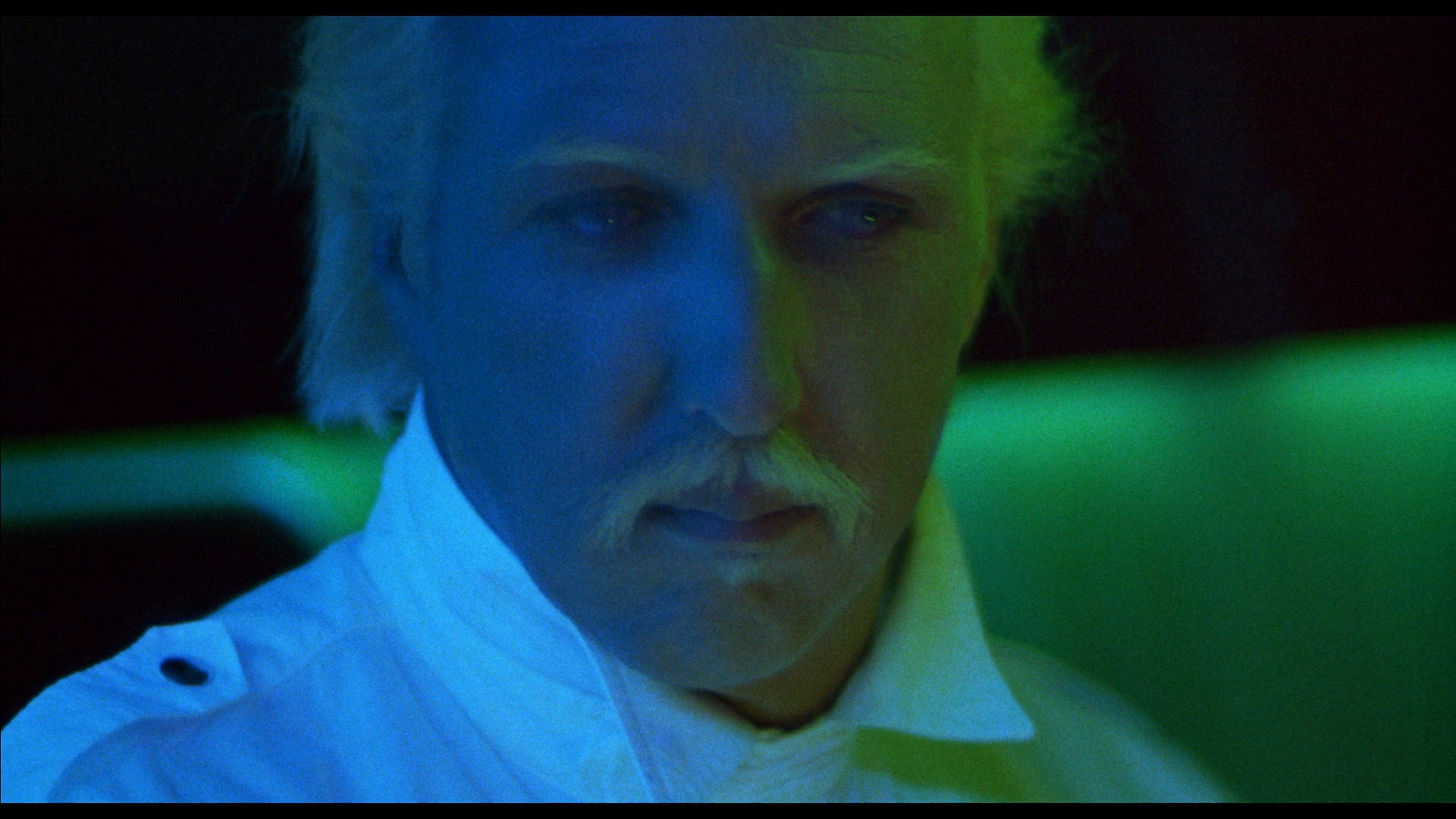 better efforts and an earlier indication of his cyber fascination is 1988's Nightmare at Noon, a desert action-horror romp with a cast made in B-movie heaven including Wings Hauser, Bo Hopkins, George Kennedy, Brion James, and Kimberly Beck, plus one of his numerous scores by Stanley Myers and a young Hans Zimmer. Sent to straight to VHS in the U.S. via Republic and later issued on DVD by Image Entertainment and Simitar, plus a later Blu-ray from Scream Factory in 2018, the film has been reissued in its definitive version (to date, at least!) from Arrow Video on Blu-ray. The fun starts with a nocturnal computer hacking raid led by an albino Brion James into a small town's water supply, which also involves brutally murdered a poor local who happens to stumble on them. Enter Hauser and
better efforts and an earlier indication of his cyber fascination is 1988's Nightmare at Noon, a desert action-horror romp with a cast made in B-movie heaven including Wings Hauser, Bo Hopkins, George Kennedy, Brion James, and Kimberly Beck, plus one of his numerous scores by Stanley Myers and a young Hans Zimmer. Sent to straight to VHS in the U.S. via Republic and later issued on DVD by Image Entertainment and Simitar, plus a later Blu-ray from Scream Factory in 2018, the film has been reissued in its definitive version (to date, at least!) from Arrow Video on Blu-ray. The fun starts with a nocturnal computer hacking raid led by an albino Brion James into a small town's water supply, which also involves brutally murdered a poor local who happens to stumble on them. Enter Hauser and 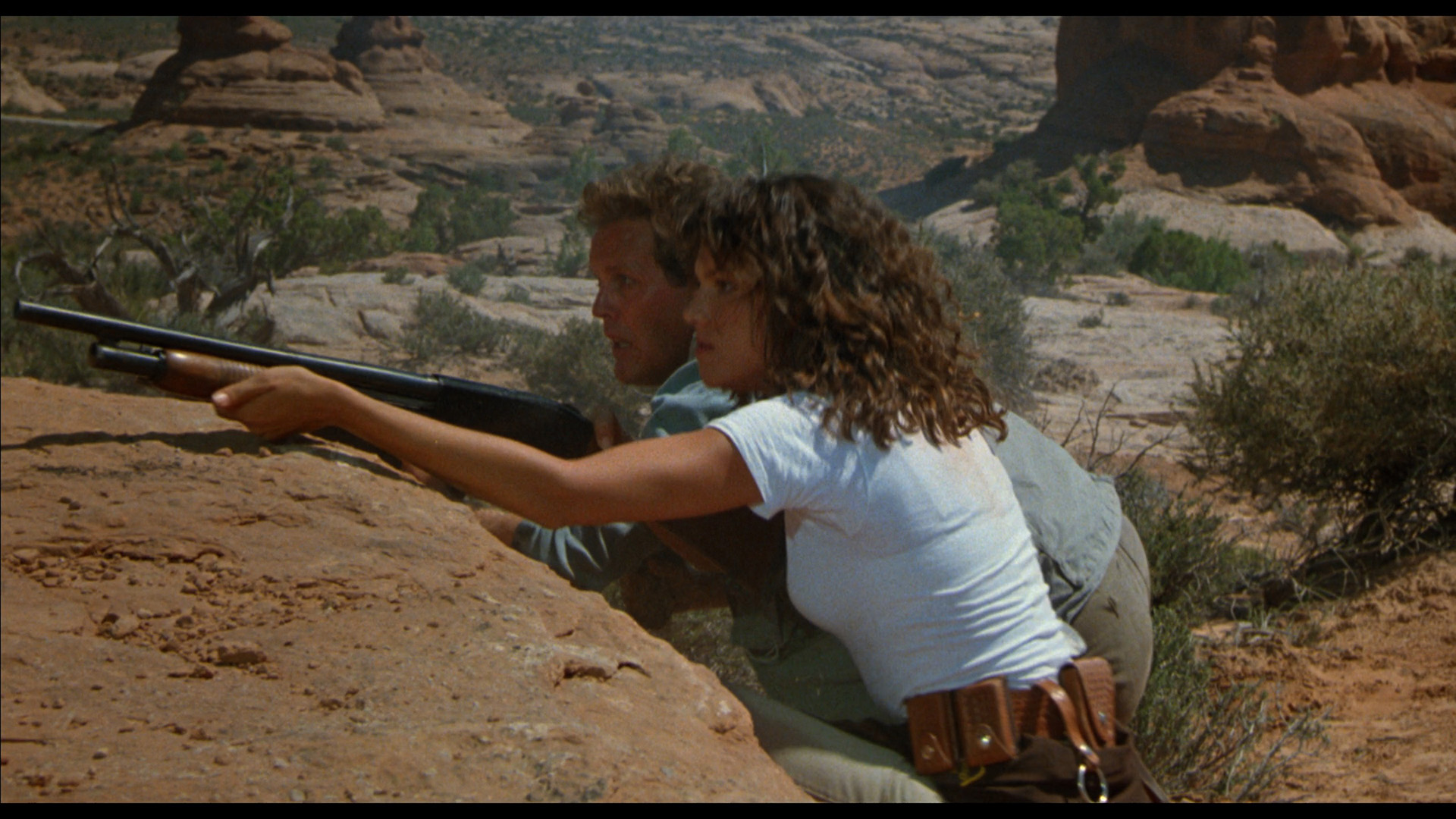 Beck in their camper who stop off at a diner, only to fall afoul of a violent, irrational assault on their waitress by a bearded resident in overalls. As it turns out, the town has been corralled into a testing ground for a new toxin, with local sheriff Kennedy and no-nonsense Hopkins pulled into the mix as well. Trashy and enjoyable, it's a virtual nonstop parade of juicy character acting, bullets, and maniacal quasi-zombies. The prior Blu-ray only ported over the DVD's making-of featurette and the trailer (plus a gallery), but this one features a beautiful new restoration from the negative with English 2.0 stereo or DTS-HD MA 5.1 audio options (and English SDH subs). The preexisting featurette (33m15s), part of a series by the director's Omega Entertainment covering all his films, is here with Mastorakis narrating production footage and covering the making accompanied by a really loud music score. An additional batch of behind-the-scenes footage (49m15s) gives you a longer look at the production, followed by on-set interviews with Hauser (12m39s), a gum-chomping Hopkins (11m6s), Beck (7m36s), Kennedy (4m28s), and James (17m9s), who looks really freaky in his full albino getup here. Also included are the trailer and a 12m30s gallery. Featuring reversible sleeve art including a new design by Graham Humphreys, the release also includes (in its first pressing) a booklet with an essay by Johnny Mains. Buy here or here.
Beck in their camper who stop off at a diner, only to fall afoul of a violent, irrational assault on their waitress by a bearded resident in overalls. As it turns out, the town has been corralled into a testing ground for a new toxin, with local sheriff Kennedy and no-nonsense Hopkins pulled into the mix as well. Trashy and enjoyable, it's a virtual nonstop parade of juicy character acting, bullets, and maniacal quasi-zombies. The prior Blu-ray only ported over the DVD's making-of featurette and the trailer (plus a gallery), but this one features a beautiful new restoration from the negative with English 2.0 stereo or DTS-HD MA 5.1 audio options (and English SDH subs). The preexisting featurette (33m15s), part of a series by the director's Omega Entertainment covering all his films, is here with Mastorakis narrating production footage and covering the making accompanied by a really loud music score. An additional batch of behind-the-scenes footage (49m15s) gives you a longer look at the production, followed by on-set interviews with Hauser (12m39s), a gum-chomping Hopkins (11m6s), Beck (7m36s), Kennedy (4m28s), and James (17m9s), who looks really freaky in his full albino getup here. Also included are the trailer and a 12m30s gallery. Featuring reversible sleeve art including a new design by Graham Humphreys, the release also includes (in its first pressing) a booklet with an essay by Johnny Mains. Buy here or here.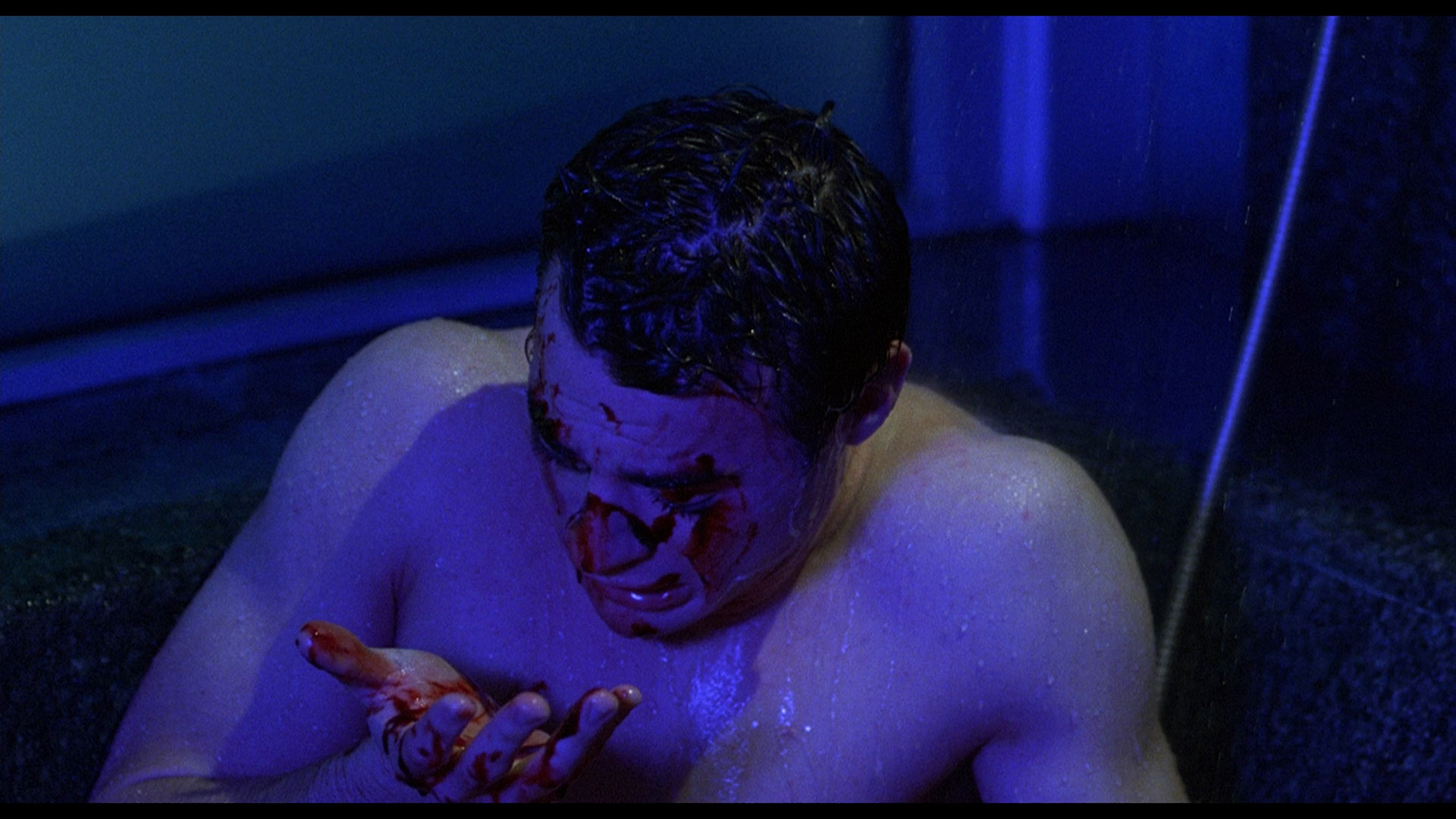 She discovers he's been chatting with other women online and decides to pose as him to find out how far it's gone, while her sister (Nicholette Sheridan) comes by as a temporary caregiver. Unfortunately Sondra ends up falling afoul of a
She discovers he's been chatting with other women online and decides to pose as him to find out how far it's gone, while her sister (Nicholette Sheridan) comes by as a temporary caregiver. Unfortunately Sondra ends up falling afoul of a 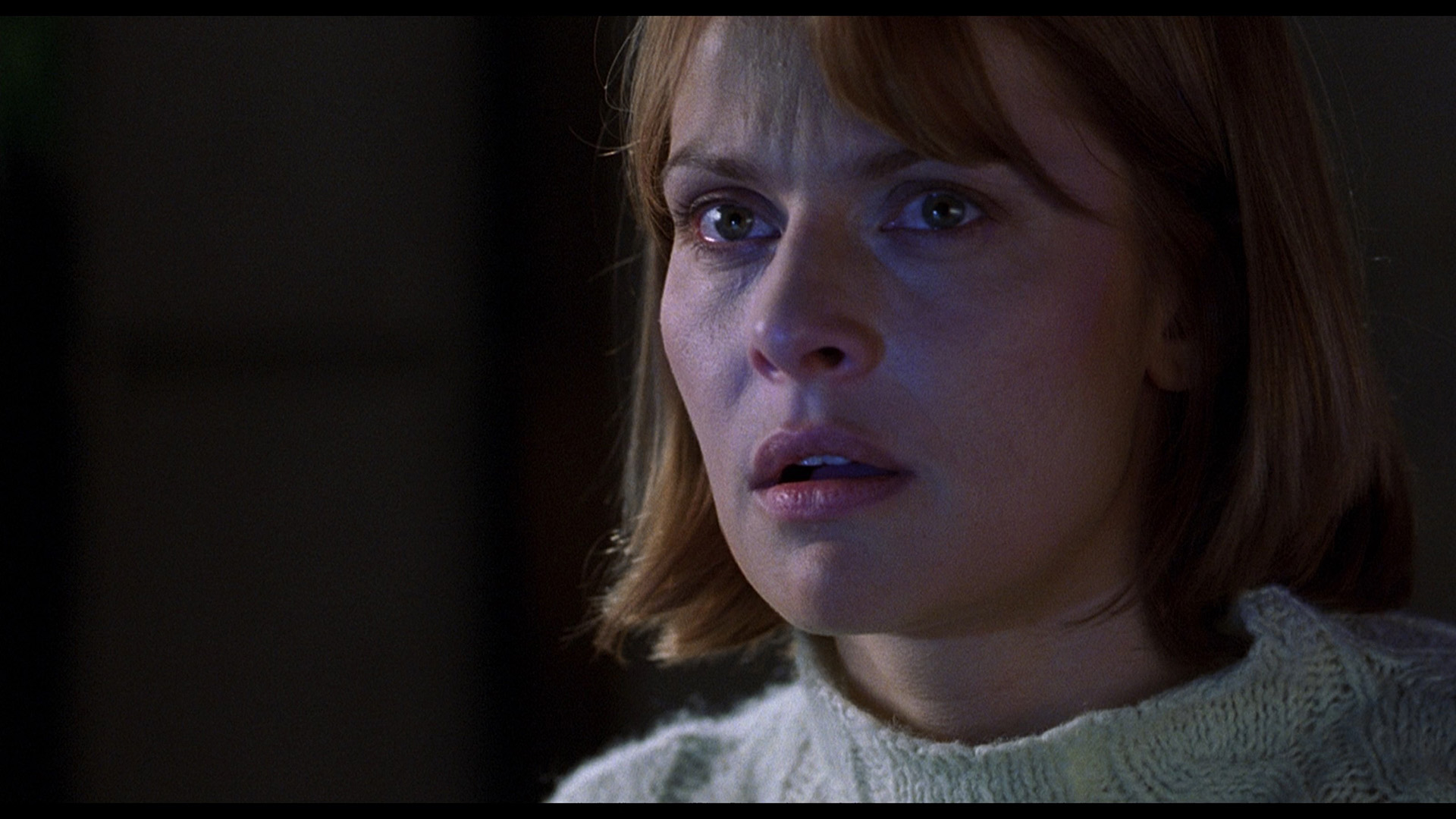 maniac named Werther (Jeffrey Dean) who hacks up women with a butcher knife in the shower, so it's time to call in the FBI headed by none other than Huey Lewis. With music video editing and some VR thrown in for good measure, this one obviously strives to be a Rear Window for the AOL age with Kinski's wheelchair-bound amateur sleuth putting herself in peril seemingly every five minutes. It's silly to the extreme, of course, but if you're looking for the perfect film to chase down a viewing of The Lawnmower Man, here you go. Again the Arrow Video Blu-ray release has a slick a/v presentation that shows this goofiness off on its best behavior, and the DTS-HD 2.0 and especially 5.1 English tracks are wild listening with tons of exaggerated surround effects peppered throughout. The making-of featurette (38m1s) from the earlier Image/Omega DVD is here with Mastorakis chatting about the Hitchcock influence and the production process of bringing to life this story of homicide a la Windows 2000. A second retrospective featurette (28m10s) created later takes another look at the film, noting how it used plentiful real night shooting and made use of its novel glass house location. Then you get archival interviews with Daltrey (20m27s) and Lewis (9m56s) on the set, followed by the trailer and a gallery of 35 images. Buy here or here.
maniac named Werther (Jeffrey Dean) who hacks up women with a butcher knife in the shower, so it's time to call in the FBI headed by none other than Huey Lewis. With music video editing and some VR thrown in for good measure, this one obviously strives to be a Rear Window for the AOL age with Kinski's wheelchair-bound amateur sleuth putting herself in peril seemingly every five minutes. It's silly to the extreme, of course, but if you're looking for the perfect film to chase down a viewing of The Lawnmower Man, here you go. Again the Arrow Video Blu-ray release has a slick a/v presentation that shows this goofiness off on its best behavior, and the DTS-HD 2.0 and especially 5.1 English tracks are wild listening with tons of exaggerated surround effects peppered throughout. The making-of featurette (38m1s) from the earlier Image/Omega DVD is here with Mastorakis chatting about the Hitchcock influence and the production process of bringing to life this story of homicide a la Windows 2000. A second retrospective featurette (28m10s) created later takes another look at the film, noting how it used plentiful real night shooting and made use of its novel glass house location. Then you get archival interviews with Daltrey (20m27s) and Lewis (9m56s) on the set, followed by the trailer and a gallery of 35 images. Buy here or here.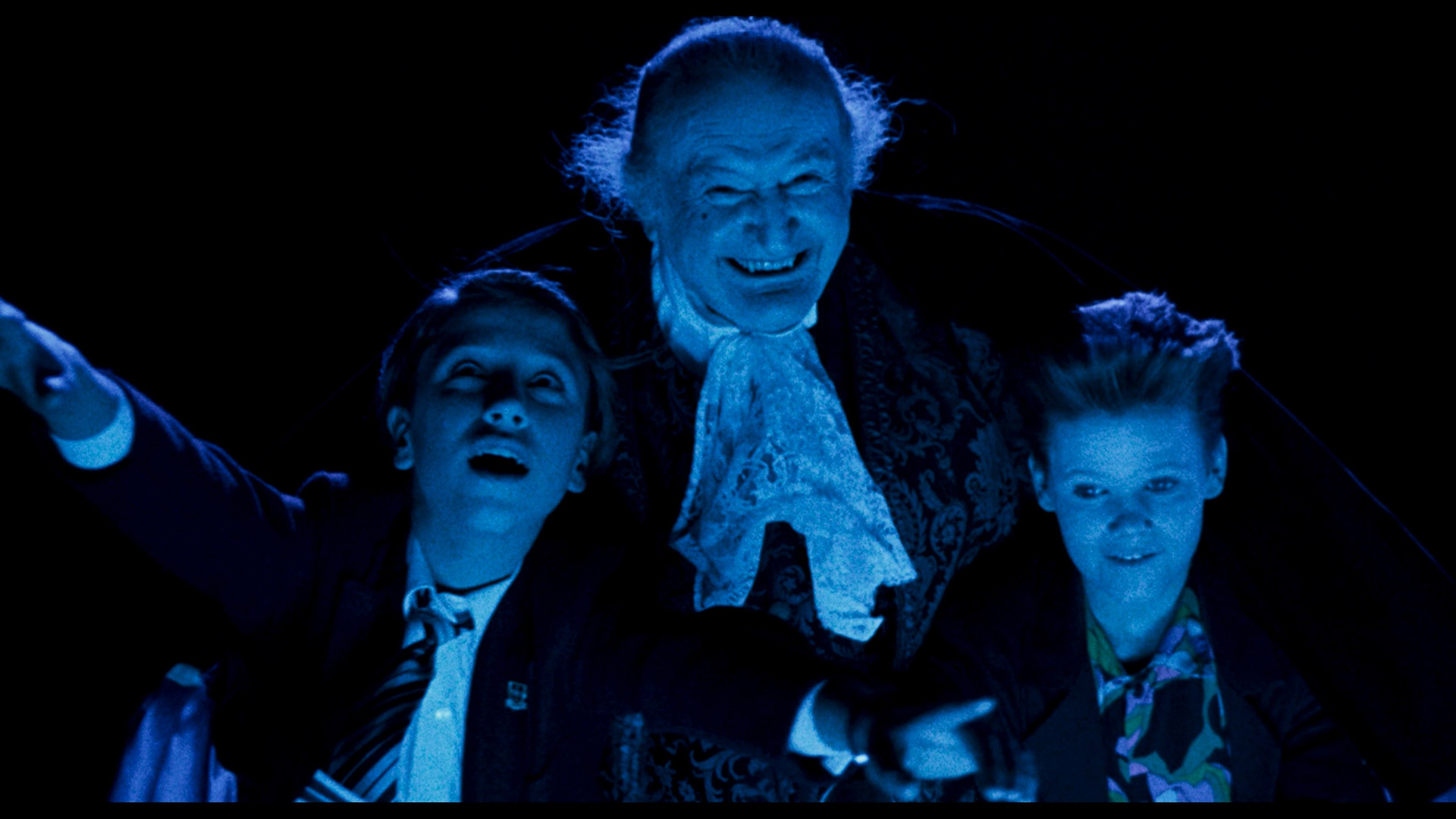 American for a visit. After an early odd incident at a carnival and other peculiar occurrences, Lonny (Justin Gocke) starts to think the old man is actually a creature of the night whose near-death moments might have a deeper meaning. Of course, it
American for a visit. After an early odd incident at a carnival and other peculiar occurrences, Lonny (Justin Gocke) starts to think the old man is actually a creature of the night whose near-death moments might have a deeper meaning. Of course, it 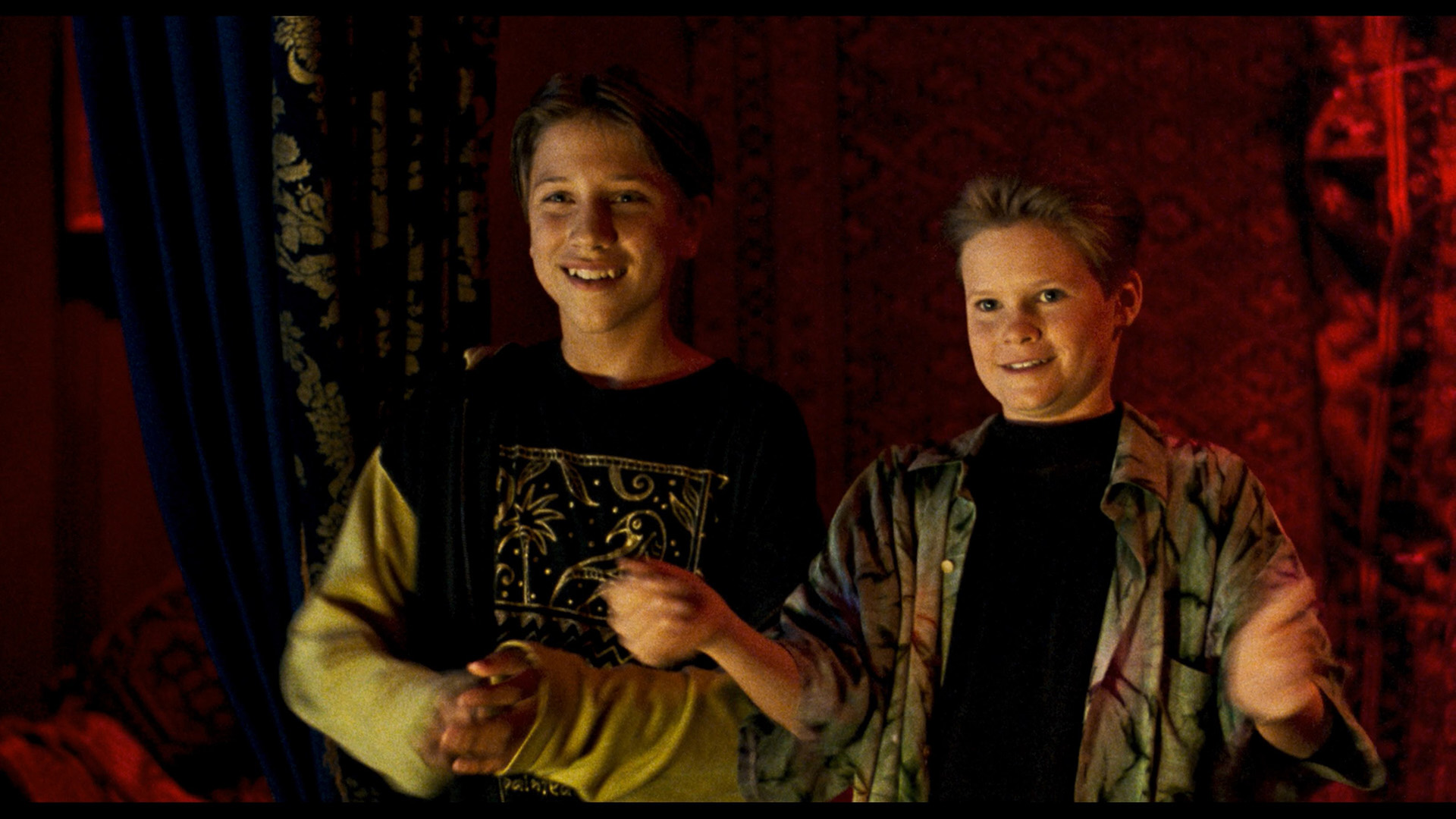 isn't long before we find out he's right as Lonny and new pal Ernie (Noel Appleby) bear witness to the kooky consequences of having a supernatural relative. There's actually a lot of style here including Gothic candlelight atmosphere, crazy red and blue lighting, and effervescent flying sequences; it's the kind of thing that could easily stick with you after an accidental afternoon viewing. Another one picked up by Republic in the U.S. back in the day, the film looks terrific here with a very saturated and striking transfer that gives the film a ton of atmosphere you couldn't really appreciate on tape; that also goes for the aforementioned, very active 5.1 and 2.0 mixes that swirl with activity throughout. A commentary by Blyth and screenwriter Michael Heath moderated by Severin's David Gregory starts off explaining the film's original titles, Moonrise and Grampire, stemming from its original as a multi-part radio play. They go into detail about the creation process including the casting of Lewis, the shooting in Auckland, the pantomime comedy tradition at play, the bad luck of budget cuts filming at the start of the Iraqui War, changes from the original conception, and tons more. In "Grandpa Remembers Grandpa" (16m32s), actor Daniel Roebuck shows off his renowned Munsters collection and reminisces about Lewis's accomplishments as a comic actor (including the Grandpa role Roebuck himself took over in the Rob Zombie film). Then in "My Husband Was a Vampire" (17m12s), Karen Lewis appears over Zoom to look back at life with her beloved TV monster spouse and how much he thoroughly embraced the persona that made him famous. Then the disc closes out with the trailer and all six episodes of the Moonrise radio play (12 minutes each), which is a treat to compare to its big screen counterpart including a very different portrayal of its fanged grandpa. Buy here or here.
isn't long before we find out he's right as Lonny and new pal Ernie (Noel Appleby) bear witness to the kooky consequences of having a supernatural relative. There's actually a lot of style here including Gothic candlelight atmosphere, crazy red and blue lighting, and effervescent flying sequences; it's the kind of thing that could easily stick with you after an accidental afternoon viewing. Another one picked up by Republic in the U.S. back in the day, the film looks terrific here with a very saturated and striking transfer that gives the film a ton of atmosphere you couldn't really appreciate on tape; that also goes for the aforementioned, very active 5.1 and 2.0 mixes that swirl with activity throughout. A commentary by Blyth and screenwriter Michael Heath moderated by Severin's David Gregory starts off explaining the film's original titles, Moonrise and Grampire, stemming from its original as a multi-part radio play. They go into detail about the creation process including the casting of Lewis, the shooting in Auckland, the pantomime comedy tradition at play, the bad luck of budget cuts filming at the start of the Iraqui War, changes from the original conception, and tons more. In "Grandpa Remembers Grandpa" (16m32s), actor Daniel Roebuck shows off his renowned Munsters collection and reminisces about Lewis's accomplishments as a comic actor (including the Grandpa role Roebuck himself took over in the Rob Zombie film). Then in "My Husband Was a Vampire" (17m12s), Karen Lewis appears over Zoom to look back at life with her beloved TV monster spouse and how much he thoroughly embraced the persona that made him famous. Then the disc closes out with the trailer and all six episodes of the Moonrise radio play (12 minutes each), which is a treat to compare to its big screen counterpart including a very different portrayal of its fanged grandpa. Buy here or here. 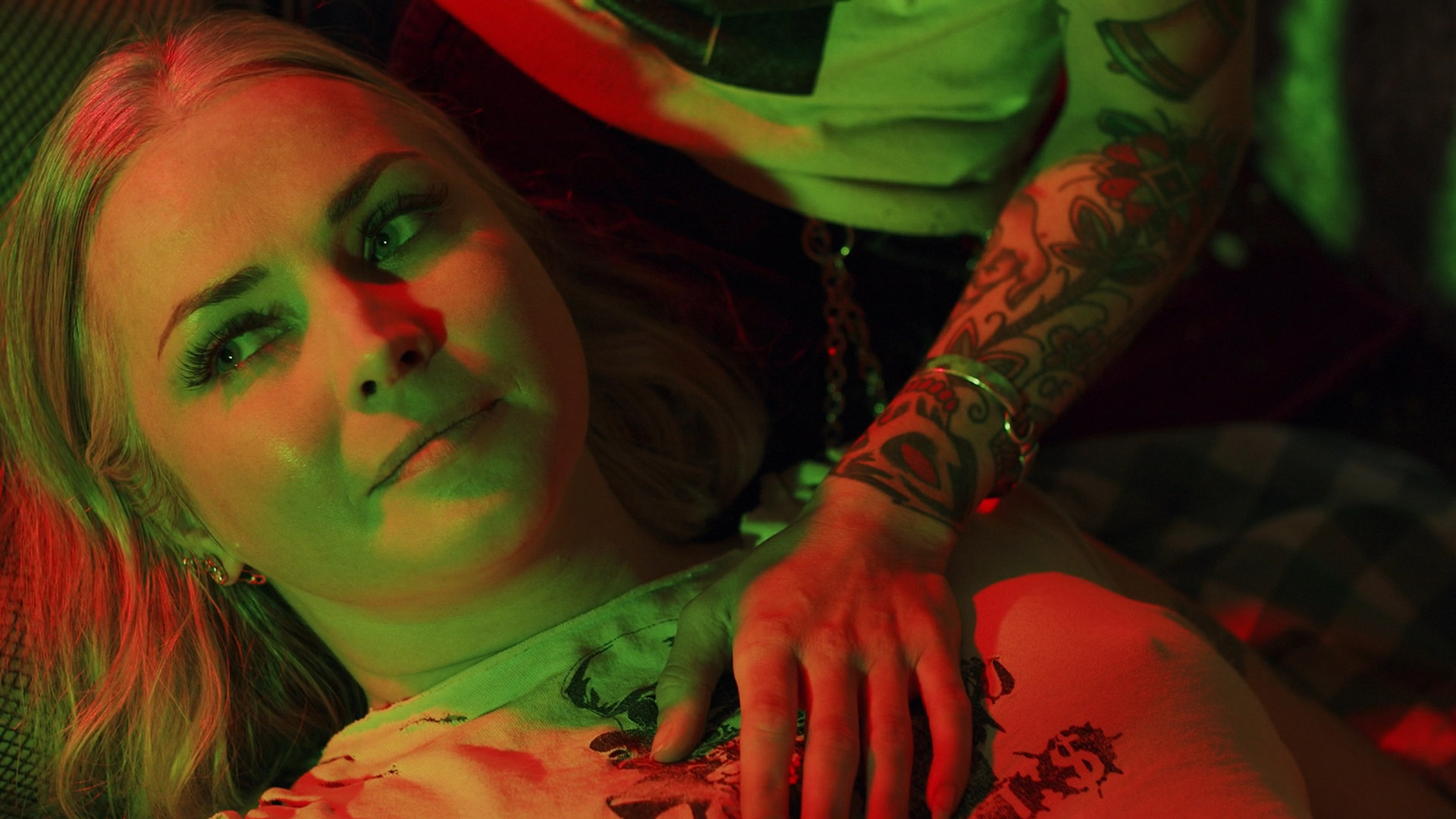 Troma-style sensibility. Erin Brown, formerly known as Misty Mundae, stars as Aloe, who wanders the crumbling remains of civilization (i.e., Dayton, Ohio) with her lover, Vera (Allison Egan). The matriarchal society that exists now is controlled by various female gangs ruling over their own turf, and for reasons that don't become clear for a long time, our protagonists are on a mission to kill a toxic male named Dirtbag Mike. Along the way they encounter a huge number of oddball characters, with Linnea Quigley popping up for what amounts to a generous cameo. The film often looks amazing with psychedelic lighting and a striking grunge aesthetic, and as always Brown is so entertaining to watch she should be headlining bigger projects. She and Egan have nice chemistry as well, and director Victor Bonacore (Diary of a Deadbeat) knows his way around a foul-mouthed turn of phrase. However, that running time is way too indulgent for the material, especially given how much it wants to be a modern exploitation movie; you
Troma-style sensibility. Erin Brown, formerly known as Misty Mundae, stars as Aloe, who wanders the crumbling remains of civilization (i.e., Dayton, Ohio) with her lover, Vera (Allison Egan). The matriarchal society that exists now is controlled by various female gangs ruling over their own turf, and for reasons that don't become clear for a long time, our protagonists are on a mission to kill a toxic male named Dirtbag Mike. Along the way they encounter a huge number of oddball characters, with Linnea Quigley popping up for what amounts to a generous cameo. The film often looks amazing with psychedelic lighting and a striking grunge aesthetic, and as always Brown is so entertaining to watch she should be headlining bigger projects. She and Egan have nice chemistry as well, and director Victor Bonacore (Diary of a Deadbeat) knows his way around a foul-mouthed turn of phrase. However, that running time is way too indulgent for the material, especially given how much it wants to be a modern exploitation movie; you 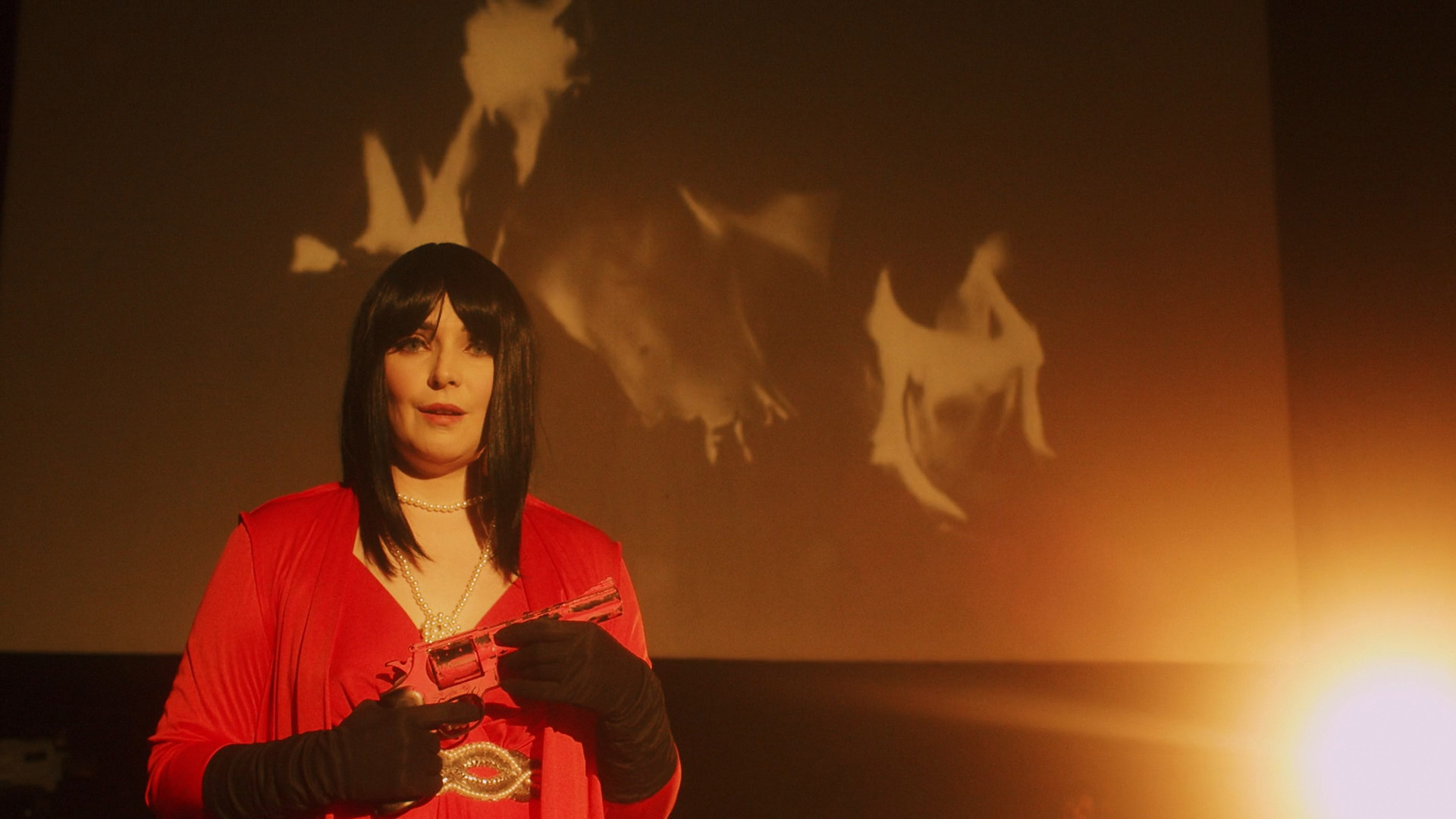 can easily see where half an hour could have been shorn away much to the film's benefit. Culture Shock Releasing's Blu-ray edition is a jam-packed one with the film itself benefiting from a presentation that shows off its bold aesthetic to fine effect, and Brown and Egan provide an engaging audio commentary explaining how they approached their roles, their rapport and past experience in various capacities with their director and co-stars, the background stories behind many of the non-actors involved, and the joys of shooting in Ohio. Dwarfing the running time of the film itself is "End of Men" (183m35s), a collection of raw making-of footage covering the whole enchilada with various cast and crew comments in between. "Origins" (14m23s) features Hannah Forman and Ami Goodheart talking about all-girl punk, the band Thrust, and the 'zine community that spawned the source short story, while “Scary Mary’s Sinema” (49m43s) is a collection of VHS-shot home movies (silent but with industrial music scores) like "The Hellfire," "Raw Footage," and "Happy Birthday Mary," including Brown, filmmaker Zach Shildwachter (even more naked here than in his brief role in Thrust!), and the undeniably unique imagery of a guy in a werewolf mask getting an on-camera footjob. "Movie Music & Soundtrack Stuff" (33m20s) features the duo of Dirty/Clean talking about their band and how they approached the music for the film, "Thrust Weekend" (45m24s) commemorates a live concert and other activities for a Dayton weekend dedicated to the film, and "Yas Scream Queens" (13m33s) features Quigley and Sadie Tate talking about their favorite roles and what they think of genre films like this. Also included are the trailer and a bonus Bonacore short film “Triangle" (24m21s), also staring Brown and mostly an experimental freak-out, with an optional commentary by the director and composer Caleab Wyant. Buy here or here.
can easily see where half an hour could have been shorn away much to the film's benefit. Culture Shock Releasing's Blu-ray edition is a jam-packed one with the film itself benefiting from a presentation that shows off its bold aesthetic to fine effect, and Brown and Egan provide an engaging audio commentary explaining how they approached their roles, their rapport and past experience in various capacities with their director and co-stars, the background stories behind many of the non-actors involved, and the joys of shooting in Ohio. Dwarfing the running time of the film itself is "End of Men" (183m35s), a collection of raw making-of footage covering the whole enchilada with various cast and crew comments in between. "Origins" (14m23s) features Hannah Forman and Ami Goodheart talking about all-girl punk, the band Thrust, and the 'zine community that spawned the source short story, while “Scary Mary’s Sinema” (49m43s) is a collection of VHS-shot home movies (silent but with industrial music scores) like "The Hellfire," "Raw Footage," and "Happy Birthday Mary," including Brown, filmmaker Zach Shildwachter (even more naked here than in his brief role in Thrust!), and the undeniably unique imagery of a guy in a werewolf mask getting an on-camera footjob. "Movie Music & Soundtrack Stuff" (33m20s) features the duo of Dirty/Clean talking about their band and how they approached the music for the film, "Thrust Weekend" (45m24s) commemorates a live concert and other activities for a Dayton weekend dedicated to the film, and "Yas Scream Queens" (13m33s) features Quigley and Sadie Tate talking about their favorite roles and what they think of genre films like this. Also included are the trailer and a bonus Bonacore short film “Triangle" (24m21s), also staring Brown and mostly an experimental freak-out, with an optional commentary by the director and composer Caleab Wyant. Buy here or here.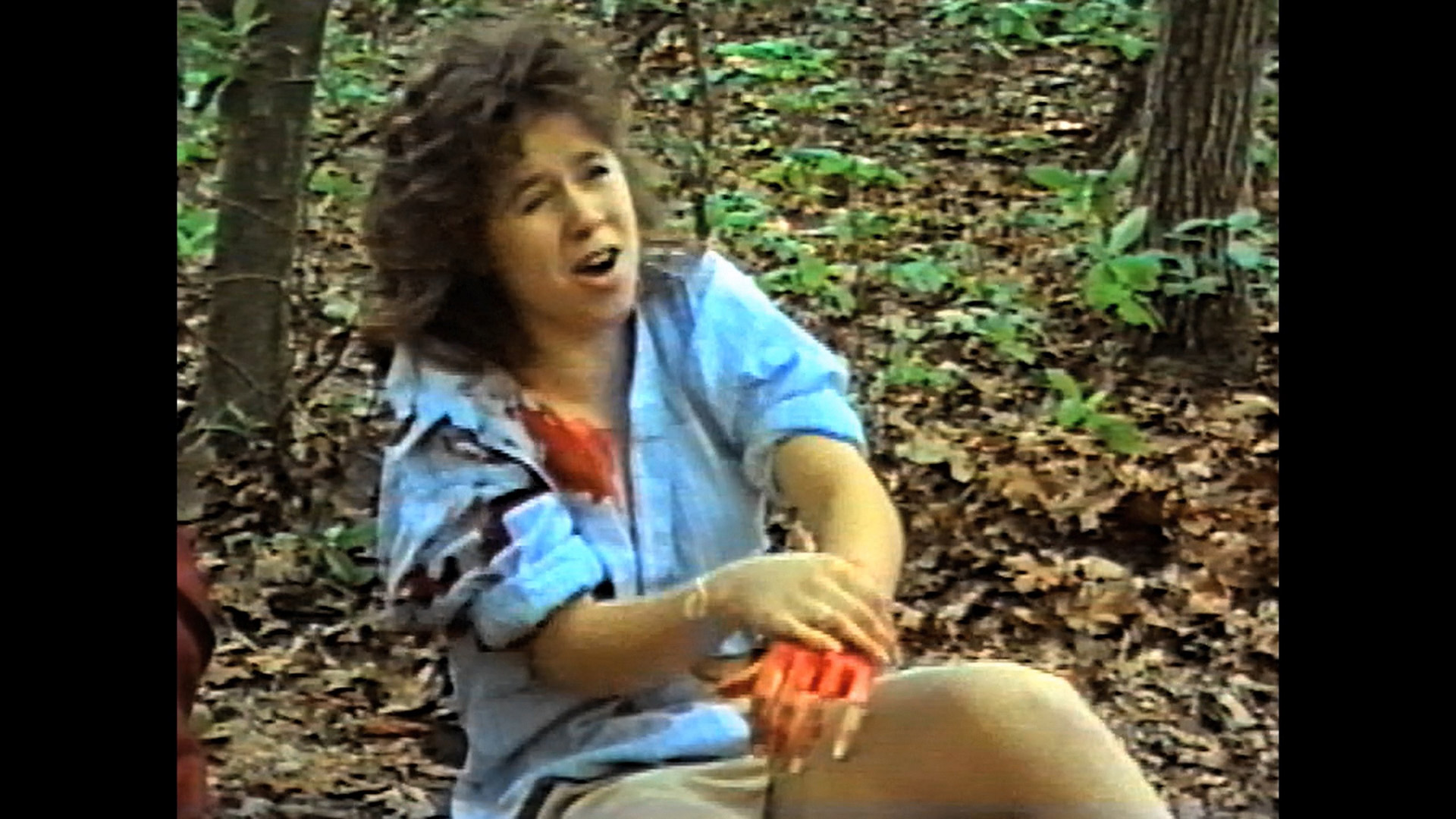 inflated running times, and going back to Saturn's Core for a minute, the unlikely parade of W.A.V.E. titles making the jump from VHS to Blu-ray continues with 1991's Dead North, a 110-minute slasher SOV opus directed by company founder Gary Whitson in the wild woods of New Jersey. It's hard to outdo the synopsis of the film found on the sleeve itself promising a slasher soap opera peppered with a "meandering mosaic of endless red herrings, deranged Nam vets, bitter office rivalries, perilous punji pits, and puffy brown plaid couches." That's pretty much what you get here as three couples plan for and eventually take off for a weekend camping trip that turns deadly when a guy lugging an axe around decides to make them his next victims. Occasional bondage detours make it obvious who was behind
inflated running times, and going back to Saturn's Core for a minute, the unlikely parade of W.A.V.E. titles making the jump from VHS to Blu-ray continues with 1991's Dead North, a 110-minute slasher SOV opus directed by company founder Gary Whitson in the wild woods of New Jersey. It's hard to outdo the synopsis of the film found on the sleeve itself promising a slasher soap opera peppered with a "meandering mosaic of endless red herrings, deranged Nam vets, bitter office rivalries, perilous punji pits, and puffy brown plaid couches." That's pretty much what you get here as three couples plan for and eventually take off for a weekend camping trip that turns deadly when a guy lugging an axe around decides to make them his next victims. Occasional bondage detours make it obvious who was behind 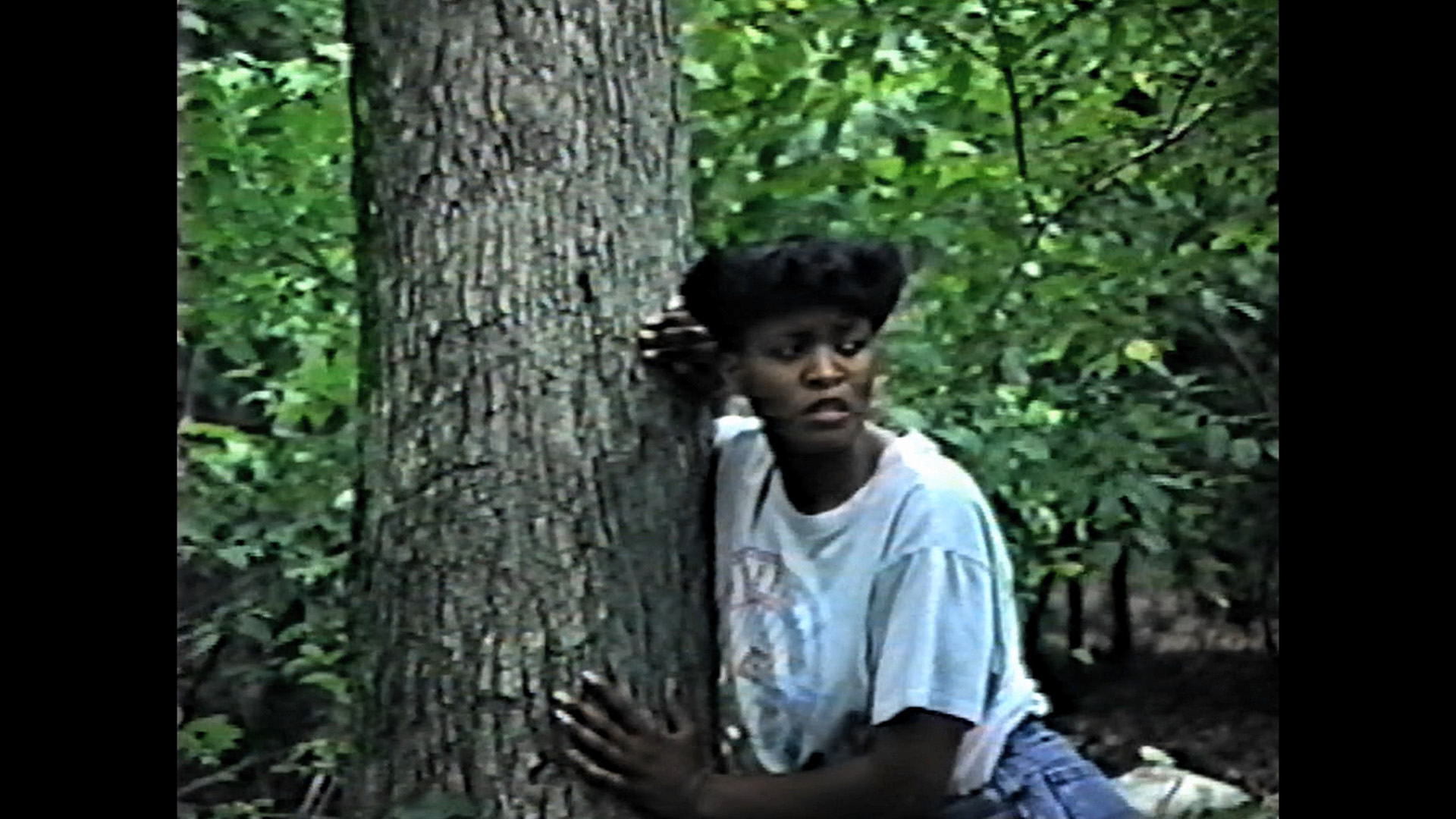 the camera for this one, while the real-time fixation of mundane procedures like packing and tent-pitching make this feel like a camcorder hack-and-slash homage to Jeanne Dielman. Lots of drama ensues with the various partners trying to or succeeding in sleeping with each other, and if that doesn't float your boat, just tough it out until the crazy final half hour when the body count and plot twists suddenly go through the roof. If you're an SOV junkie, this should be a no brainer. Incredibly, the Blu-ray (which looks exactly as you'd expect for a shot-on-VHS title) features two audio commentaries: the first with Whitson and Saturn's Core's Ross Snyder is a fun primer on the W.A.V.E. philosophy and history around the early '90s and pinpoints everyone in the fairly large cast, while a second with Richard Moog, author of Analog Nightmares: The Shot on Video Horror Films of 1982-1995, approaches this as part of the SOV slasher wave that broke in the '80s and continued for many years after the subgenre's theatrical prospects were long gone. He also points out the major players and how this is significant as one of W.A.V.E.'s earliest feature-length productions, setting the stage for what was to come. Also included is 2012's The Pineland Murders! (98m39s), a slicker shot-on-digital remake that cuts to the chase a lot faster with lots of chasing through the trees and a few variations in the wrap-up. If that's not enough W.A.V.E., you also get another 1991 production, The Hanging Judge (46m9s), featuring the same stars (Clancey McCauley and Terri Lewnadowski) in a story about a woman plagued by nightmares involving a judge sentencing her to hang, which turns into a revenge plot from beyond the grave. This was also shot in the same woods and features a lot more tying up than the main feature, for obvious reasons, plus a ridiculous twist ending for good measure. Then you get another W.A.V.E. title, the 1995 short Crushed (18m42s), again with McCauley in a story about a macabre evening in which... well, you'll see when you find out the meaning of the title in the last three minutes. Also included are the original trailer and bonus ones for Mail Order Murder, Burglar from Hell, Duck! The Carbine High Massacre, Sinistre, and Ravage; the original specs also announced a Whitson interview, "True North," but that doesn't appear to be on here anywhere.) The package also comes with an insert booklet, Lunchmeat Midnight Snack: Dead North Special Edition, with news articles plus essays by Josh Schafer, Snyder, and Whitson. Buy here or here.
the camera for this one, while the real-time fixation of mundane procedures like packing and tent-pitching make this feel like a camcorder hack-and-slash homage to Jeanne Dielman. Lots of drama ensues with the various partners trying to or succeeding in sleeping with each other, and if that doesn't float your boat, just tough it out until the crazy final half hour when the body count and plot twists suddenly go through the roof. If you're an SOV junkie, this should be a no brainer. Incredibly, the Blu-ray (which looks exactly as you'd expect for a shot-on-VHS title) features two audio commentaries: the first with Whitson and Saturn's Core's Ross Snyder is a fun primer on the W.A.V.E. philosophy and history around the early '90s and pinpoints everyone in the fairly large cast, while a second with Richard Moog, author of Analog Nightmares: The Shot on Video Horror Films of 1982-1995, approaches this as part of the SOV slasher wave that broke in the '80s and continued for many years after the subgenre's theatrical prospects were long gone. He also points out the major players and how this is significant as one of W.A.V.E.'s earliest feature-length productions, setting the stage for what was to come. Also included is 2012's The Pineland Murders! (98m39s), a slicker shot-on-digital remake that cuts to the chase a lot faster with lots of chasing through the trees and a few variations in the wrap-up. If that's not enough W.A.V.E., you also get another 1991 production, The Hanging Judge (46m9s), featuring the same stars (Clancey McCauley and Terri Lewnadowski) in a story about a woman plagued by nightmares involving a judge sentencing her to hang, which turns into a revenge plot from beyond the grave. This was also shot in the same woods and features a lot more tying up than the main feature, for obvious reasons, plus a ridiculous twist ending for good measure. Then you get another W.A.V.E. title, the 1995 short Crushed (18m42s), again with McCauley in a story about a macabre evening in which... well, you'll see when you find out the meaning of the title in the last three minutes. Also included are the original trailer and bonus ones for Mail Order Murder, Burglar from Hell, Duck! The Carbine High Massacre, Sinistre, and Ravage; the original specs also announced a Whitson interview, "True North," but that doesn't appear to be on here anywhere.) The package also comes with an insert booklet, Lunchmeat Midnight Snack: Dead North Special Edition, with news articles plus essays by Josh Schafer, Snyder, and Whitson. Buy here or here.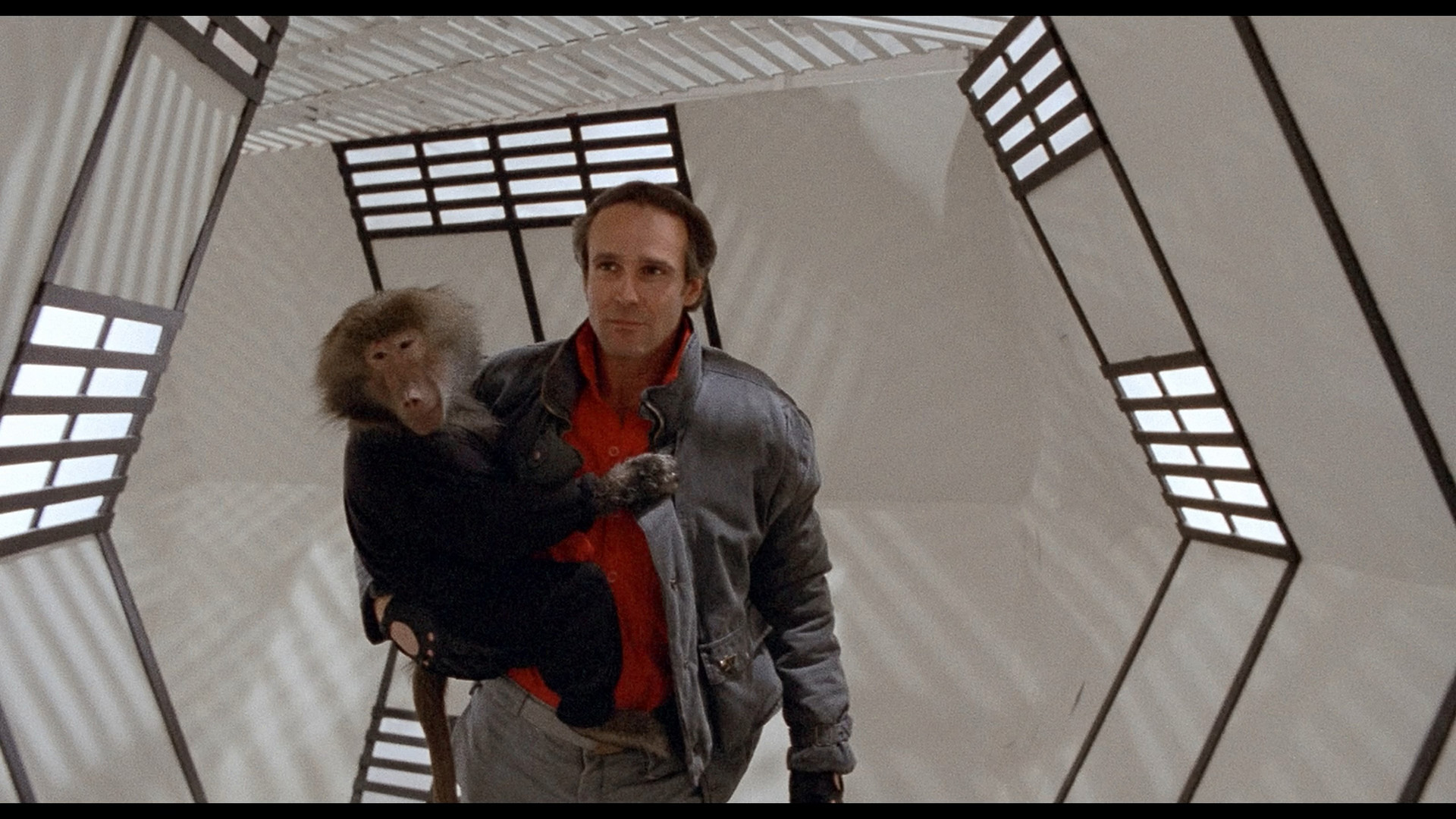 North Carolina indie didn't get much theatrical play but earned a second lease on life when it eventually landed over at MGM and played for years on their MGM HD channel back to back with its companion film, The Order of the Black Eagle, which was shot around the same time. The two films marked a brief attempt to make an action star out of actor Ian Hunter, who did absolutely nothing else, in the role of Duncan Jax, a martial arts expert and fearless secret agent who specializes in saving the world (preferably when it involves explosions and hang gliding).
North Carolina indie didn't get much theatrical play but earned a second lease on life when it eventually landed over at MGM and played for years on their MGM HD channel back to back with its companion film, The Order of the Black Eagle, which was shot around the same time. The two films marked a brief attempt to make an action star out of actor Ian Hunter, who did absolutely nothing else, in the role of Duncan Jax, a martial arts expert and fearless secret agent who specializes in saving the world (preferably when it involves explosions and hang gliding). 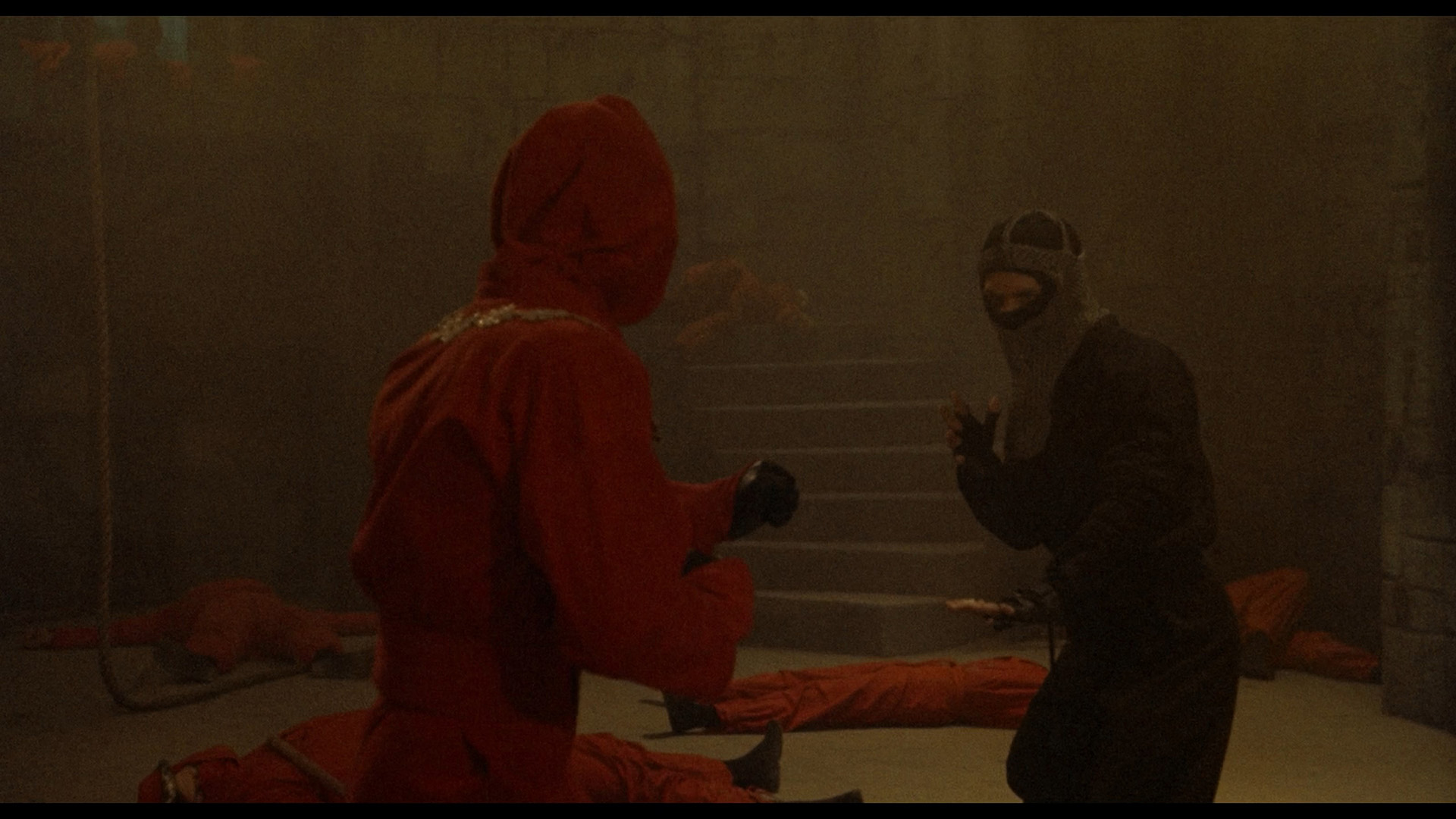 Accompanied by his baboon (named Boon, natch), he also slips in and out of ninja outfits as he embarks on his latest mission: thwarting Scarlet Leader, a mysterious villain whose Nazi henchman has a dark tie to Jax's past. Essentially a cheap men's adventure paperback brought straight to the screen, it's a pretty impressive film if you bear in mind all the gadgetry and global escapades were accomplished without leaving the Tar Heel State. Initially released as a DVD-R by MGM, the film looks significantly improved over its heavily noise reduced HD airings here on Vinegar Syndrome's VSA Region A Blu-ray featuring a new 2K scan from the 35mm interpositive. The DTS-HD MA 2.0 English mono track is nothing terribly special given how the film was originally mixed, but the theme song is still really something to behold. Keeter pops up with moderator and buddy Phil Smoot for a new commentary recorded in Charlotte, and it's a keeper with lots of production info about the North Carolina production scene, the process of location scouting including lots of hotels, and the extensive stunt work involved. There's only one video extra, but it's a huge one: "The Mission Begins" (68m29s), a sprawling look at the attempt to launch a 007-style franchise, featuring interviews with Keeter, Hunter (under his real name, Louis Dula), actor Shangtai Tuan, cinematographer Steve Shaw, stunt man Steve Winegard, stunt man Art Newkirk, camera assistant Irl Dixon and animal trainer Gerry Therrien. From the early roots with Earl Owensby and E.O. Studios through the waning of the North Carolina genre scene, it's as definitive a look at the making of the film as you could want. Limited to 6,000 units, the release also comes with an insert double-sided poster. Buy here or here.
Accompanied by his baboon (named Boon, natch), he also slips in and out of ninja outfits as he embarks on his latest mission: thwarting Scarlet Leader, a mysterious villain whose Nazi henchman has a dark tie to Jax's past. Essentially a cheap men's adventure paperback brought straight to the screen, it's a pretty impressive film if you bear in mind all the gadgetry and global escapades were accomplished without leaving the Tar Heel State. Initially released as a DVD-R by MGM, the film looks significantly improved over its heavily noise reduced HD airings here on Vinegar Syndrome's VSA Region A Blu-ray featuring a new 2K scan from the 35mm interpositive. The DTS-HD MA 2.0 English mono track is nothing terribly special given how the film was originally mixed, but the theme song is still really something to behold. Keeter pops up with moderator and buddy Phil Smoot for a new commentary recorded in Charlotte, and it's a keeper with lots of production info about the North Carolina production scene, the process of location scouting including lots of hotels, and the extensive stunt work involved. There's only one video extra, but it's a huge one: "The Mission Begins" (68m29s), a sprawling look at the attempt to launch a 007-style franchise, featuring interviews with Keeter, Hunter (under his real name, Louis Dula), actor Shangtai Tuan, cinematographer Steve Shaw, stunt man Steve Winegard, stunt man Art Newkirk, camera assistant Irl Dixon and animal trainer Gerry Therrien. From the early roots with Earl Owensby and E.O. Studios through the waning of the North Carolina genre scene, it's as definitive a look at the making of the film as you could want. Limited to 6,000 units, the release also comes with an insert double-sided poster. Buy here or here.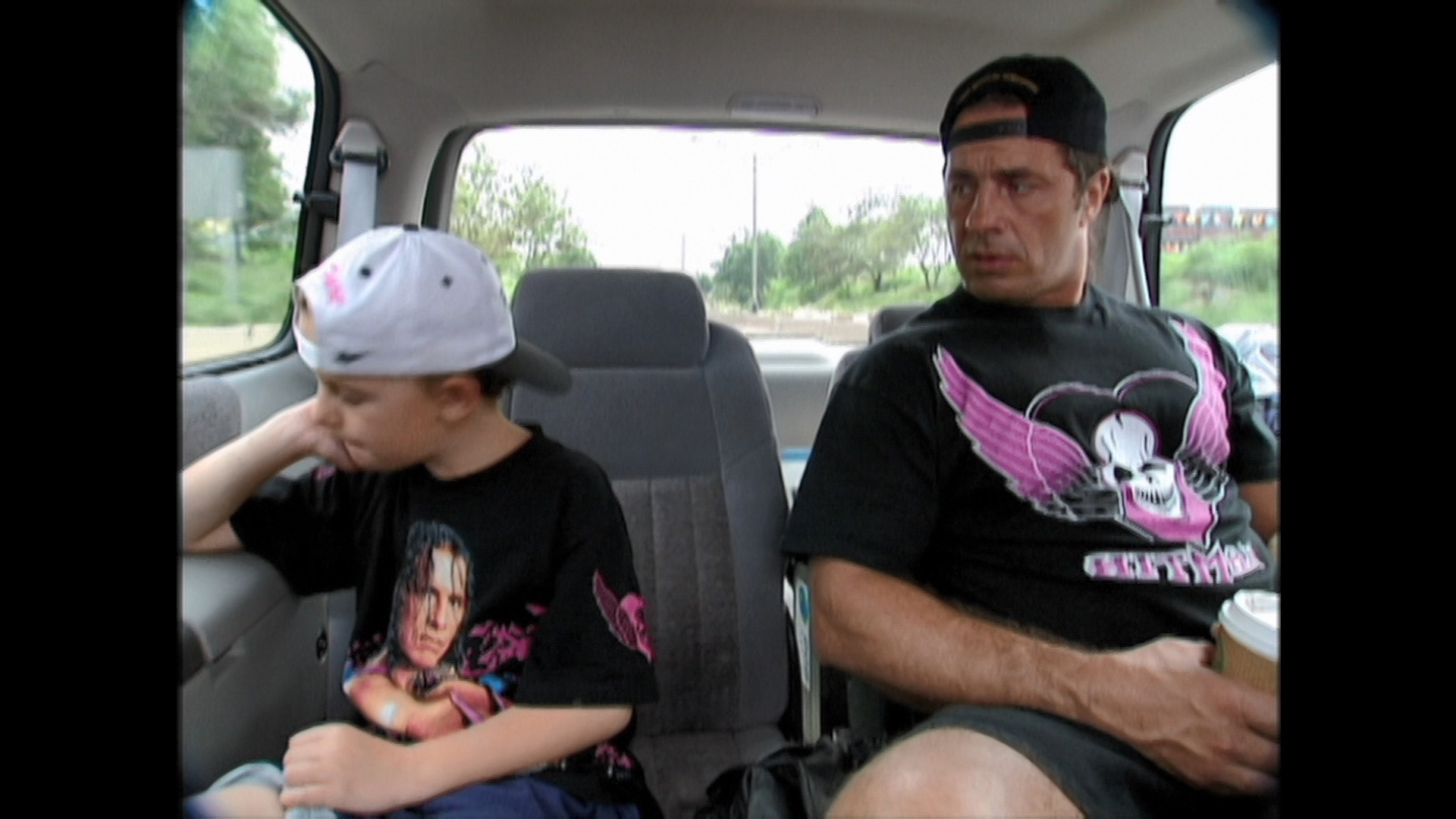 slim canon with Hitman Hart: Wrestling with Shadows, a 93-minute, 1998 documentary portrait of one of the country's most celebrated wrestlers. Bret "Hitman' Hart's professional career is a familiar one including the WWF and WCW along with his unwitting participation in the scandalous "Montreal Screwjob" fix, which many Canadians felt
slim canon with Hitman Hart: Wrestling with Shadows, a 93-minute, 1998 documentary portrait of one of the country's most celebrated wrestlers. Bret "Hitman' Hart's professional career is a familiar one including the WWF and WCW along with his unwitting participation in the scandalous "Montreal Screwjob" fix, which many Canadians felt 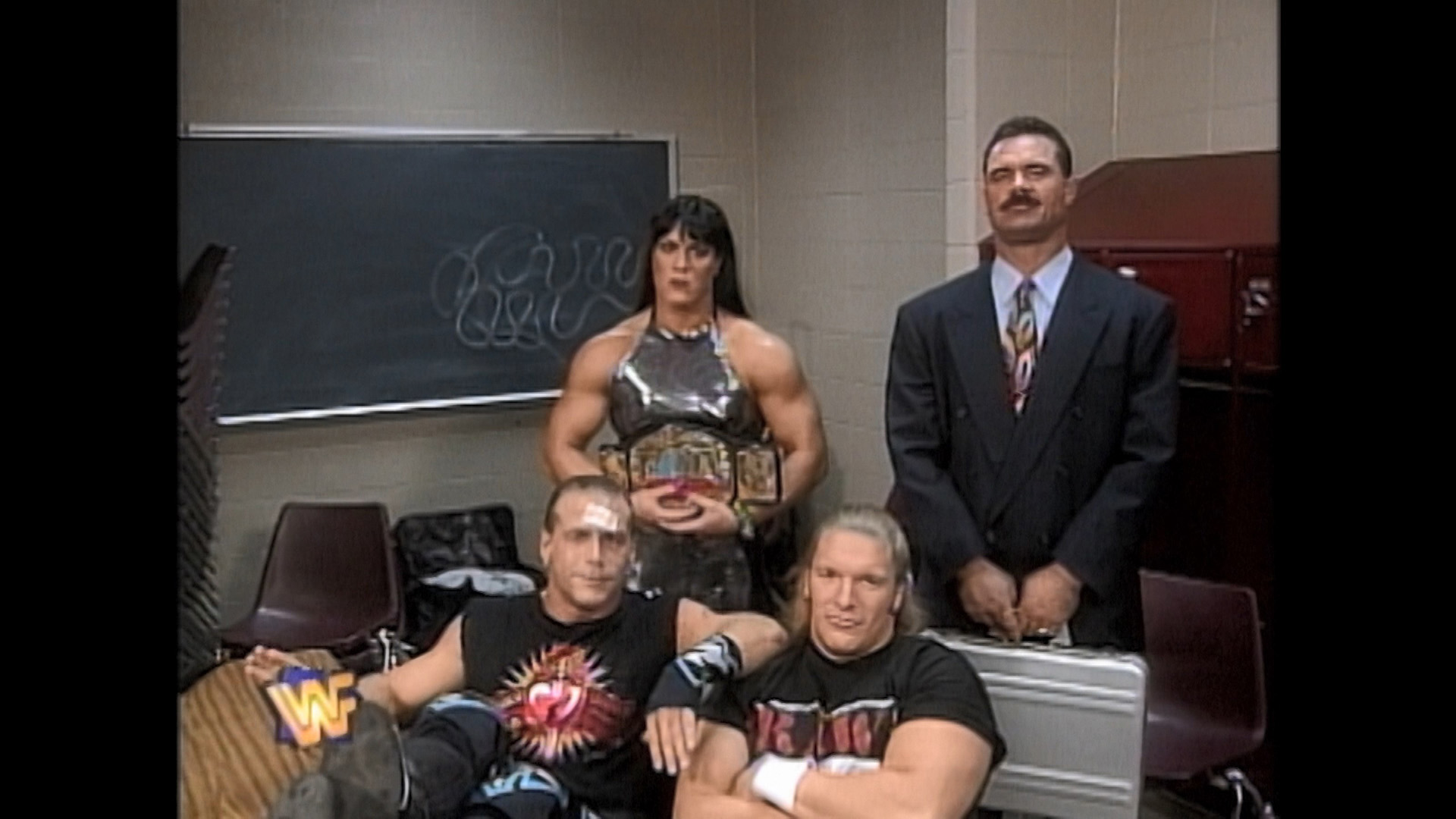 was a massive betrayal against him. The undermining of Hart's championship, largely attributed in no small part to Vince McMahon, is a big part of the doc, which captures Hart's day-to-day routine and the fan culture around wrestling at the time. Shepherded by the National Film Board of Canada, it's a compelling viewing experience even for wrestling novices as it touches on personal tragedies, philanthropy, professional crises, and the struggles of holding a family together in a business that doesn't foster healthy relationships. The death of Hart's brother, fellow wrestler Owen, in a pre-match stunt is a sad and compelling tale unto itself, covered on the CIP disc as well in the 1999 47-minute doc The Life and Death of Owen Hart, playable with an optional 52s intro by co-director Paul Jay (who also helmed Hitman Hart). The main feature is presented in a good presentation cited as being transfered and restored from the Betacam master, and given all the material had to be tape-sourced anyway, that's fine. Bret Hart and Wrestling Observer Newsletter editor Dave Meltzer contribute a very substantial audio commentary that paints a piercing portrait of a very lucrative industry in a time of transition, while also touching on the subject's personal attitudes (which are really progressive in the world of professional sports) and the many changes in his personal life since then. Hart also turns up in the new interview featurette "Anatomy of a Screwjob" (22m40s) recalling the process of making the documentary and how it coincided with the most infamous period in his life, while "Directing with Shadows" with Paul Jay features his thoughts on how the documentary idea came up, how the idea for his subject emerged, and what he thought about the stranger than fiction events that unfolded in the process. A bonus "Screwjob-specific commentary" by Hart (12m46s) was recorded after the main commentary track, done at his request to capture more of his thoughts on what went down and what he thinks about the aftermath. Also included are archival 2008 interviews with Hart (22m32s) and Jay (21m35s) for the film's tenth anniversary, and an insert booklet features a text interview with producer Sally Blake. Highly recommended. Buy here or here.
was a massive betrayal against him. The undermining of Hart's championship, largely attributed in no small part to Vince McMahon, is a big part of the doc, which captures Hart's day-to-day routine and the fan culture around wrestling at the time. Shepherded by the National Film Board of Canada, it's a compelling viewing experience even for wrestling novices as it touches on personal tragedies, philanthropy, professional crises, and the struggles of holding a family together in a business that doesn't foster healthy relationships. The death of Hart's brother, fellow wrestler Owen, in a pre-match stunt is a sad and compelling tale unto itself, covered on the CIP disc as well in the 1999 47-minute doc The Life and Death of Owen Hart, playable with an optional 52s intro by co-director Paul Jay (who also helmed Hitman Hart). The main feature is presented in a good presentation cited as being transfered and restored from the Betacam master, and given all the material had to be tape-sourced anyway, that's fine. Bret Hart and Wrestling Observer Newsletter editor Dave Meltzer contribute a very substantial audio commentary that paints a piercing portrait of a very lucrative industry in a time of transition, while also touching on the subject's personal attitudes (which are really progressive in the world of professional sports) and the many changes in his personal life since then. Hart also turns up in the new interview featurette "Anatomy of a Screwjob" (22m40s) recalling the process of making the documentary and how it coincided with the most infamous period in his life, while "Directing with Shadows" with Paul Jay features his thoughts on how the documentary idea came up, how the idea for his subject emerged, and what he thought about the stranger than fiction events that unfolded in the process. A bonus "Screwjob-specific commentary" by Hart (12m46s) was recorded after the main commentary track, done at his request to capture more of his thoughts on what went down and what he thinks about the aftermath. Also included are archival 2008 interviews with Hart (22m32s) and Jay (21m35s) for the film's tenth anniversary, and an insert booklet features a text interview with producer Sally Blake. Highly recommended. Buy here or here.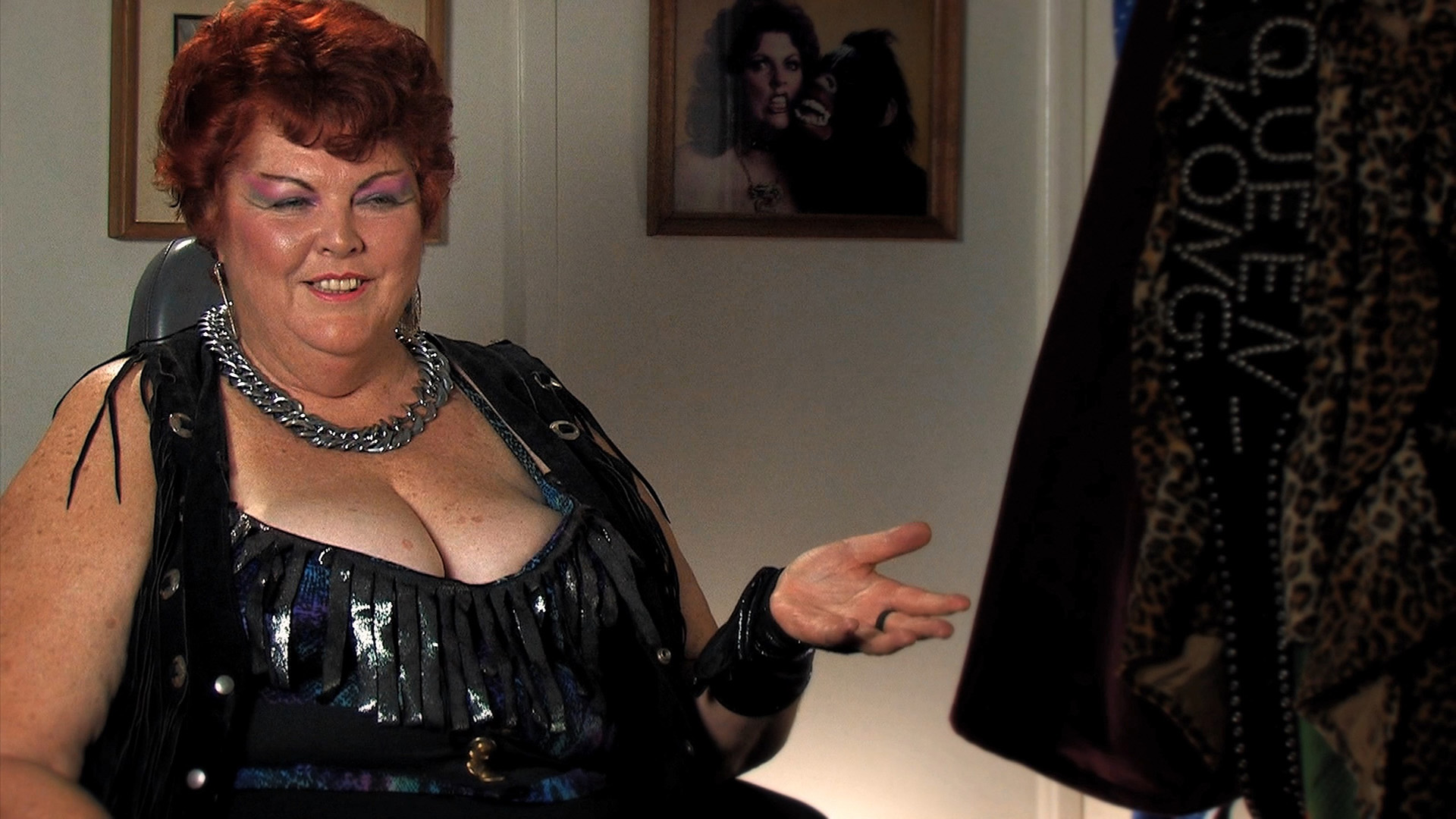 glorious run of the all-female wrestling TV extravaganza from 1986 to its abrupt cancellation in 1990. Anyone who stumbled across the show in its heyday couldn't help but get sucked into this insane world of fearless women with larger than life personas ranging from the heroic to the outright villainous (including the unforgettable Matilda the Hun). Many of the participants are interviewed here (and even get a big reunion at the end) to explain how the
glorious run of the all-female wrestling TV extravaganza from 1986 to its abrupt cancellation in 1990. Anyone who stumbled across the show in its heyday couldn't help but get sucked into this insane world of fearless women with larger than life personas ranging from the heroic to the outright villainous (including the unforgettable Matilda the Hun). Many of the participants are interviewed here (and even get a big reunion at the end) to explain how the 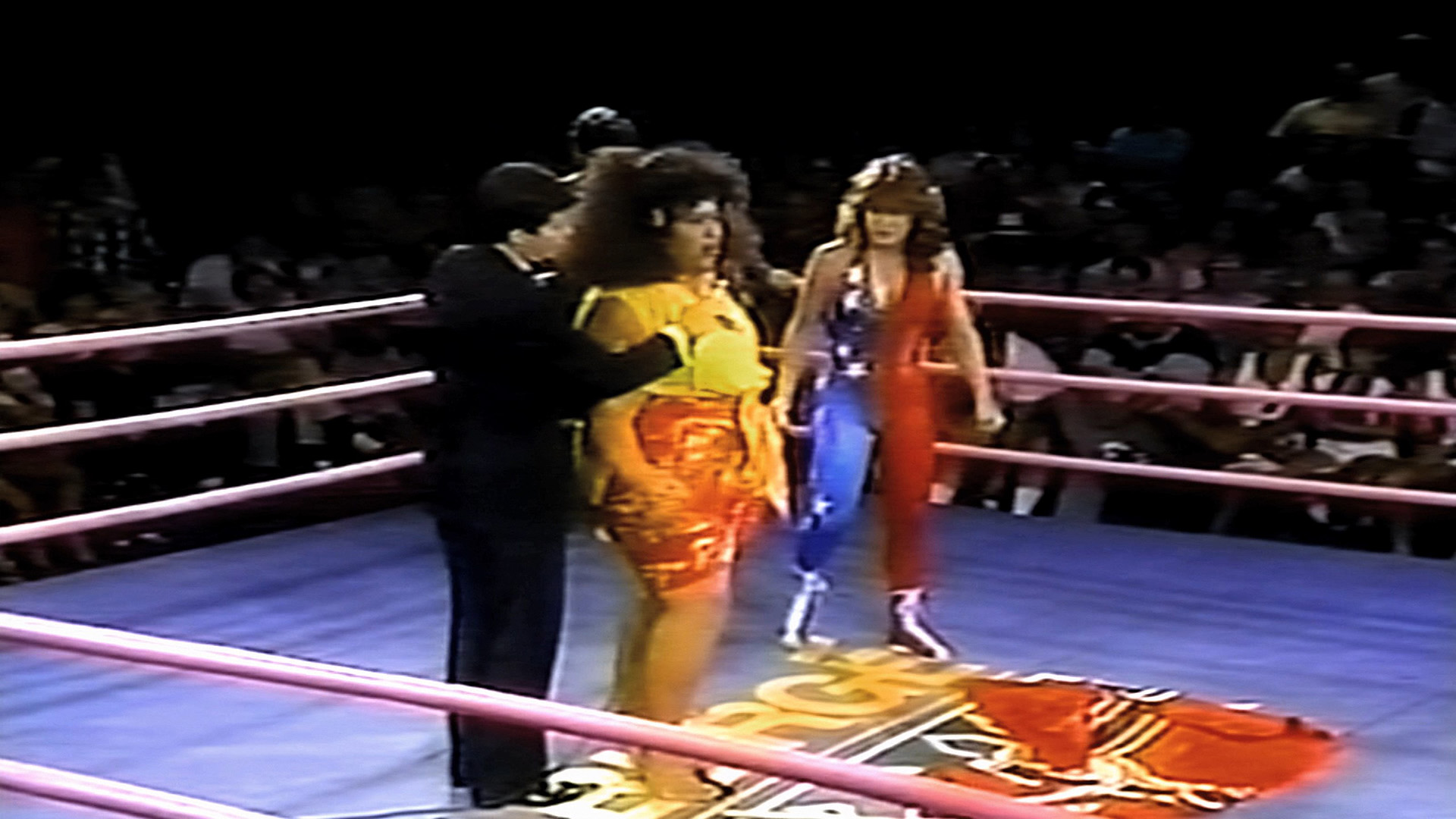 non-professional performers ended up being cast on the show, looking at the pluses and minuses of their experiences and the satisfaction they feel looking back at their legacy. For cult movie fans, the show has cachet as well for being primarily directed by Matt Cimber (Hundra, The Witch Who Came from the Sea), who co-founded the program whose original owner, Meshulam Riklis, the mastermind behind the early film career of his then-wife Pia Zadora (including the Cimber-directed Butterfly). Of course, the GLOW story went on to inspire the great fictionalized Netflix series (which was also canned prematurely), and it's always great to see the real-life participants along with the folks behind the scenes like wrestler and trainer Mando Guerrero. Initially released on DVD in 2012, the film was outfitted with some great bonus features headlined by Smashing Pumpkins' Billy Corgan (a superfan who wrote a song inspired by the show) and wrestlers Little Egypt, Matilda the Hun, and Hollywood (from the Hollywood & Vine pairing), who all have a blast chatting about their days of pop culture glory. That track is carried over for the 2022 Blu-ray edition, which features the film from the original digital master which obviously fluctuates given the material involved. (One annoyance is the presentation of all archival 1.33:1 broadcast material heavily squished to 1.78:1, but that's a bad call you can chalk up to the filmmakers.) You also get a United Film Festival Q&A (12m14s) with the same participants and lots more, a 45m52s outtake reel, the trailer, a Susie Spirit arm break report (7m21s) on the most memorable shock moment of the show, a 32m9s reel of vintage GLOW matches including some of those classic rap numbers, vintage GLOW skits (19m33s) tailored for MTV, and 10m16s of GLOW music videos including their unforgettable theme song. Buy here or here.
non-professional performers ended up being cast on the show, looking at the pluses and minuses of their experiences and the satisfaction they feel looking back at their legacy. For cult movie fans, the show has cachet as well for being primarily directed by Matt Cimber (Hundra, The Witch Who Came from the Sea), who co-founded the program whose original owner, Meshulam Riklis, the mastermind behind the early film career of his then-wife Pia Zadora (including the Cimber-directed Butterfly). Of course, the GLOW story went on to inspire the great fictionalized Netflix series (which was also canned prematurely), and it's always great to see the real-life participants along with the folks behind the scenes like wrestler and trainer Mando Guerrero. Initially released on DVD in 2012, the film was outfitted with some great bonus features headlined by Smashing Pumpkins' Billy Corgan (a superfan who wrote a song inspired by the show) and wrestlers Little Egypt, Matilda the Hun, and Hollywood (from the Hollywood & Vine pairing), who all have a blast chatting about their days of pop culture glory. That track is carried over for the 2022 Blu-ray edition, which features the film from the original digital master which obviously fluctuates given the material involved. (One annoyance is the presentation of all archival 1.33:1 broadcast material heavily squished to 1.78:1, but that's a bad call you can chalk up to the filmmakers.) You also get a United Film Festival Q&A (12m14s) with the same participants and lots more, a 45m52s outtake reel, the trailer, a Susie Spirit arm break report (7m21s) on the most memorable shock moment of the show, a 32m9s reel of vintage GLOW matches including some of those classic rap numbers, vintage GLOW skits (19m33s) tailored for MTV, and 10m16s of GLOW music videos including their unforgettable theme song. Buy here or here.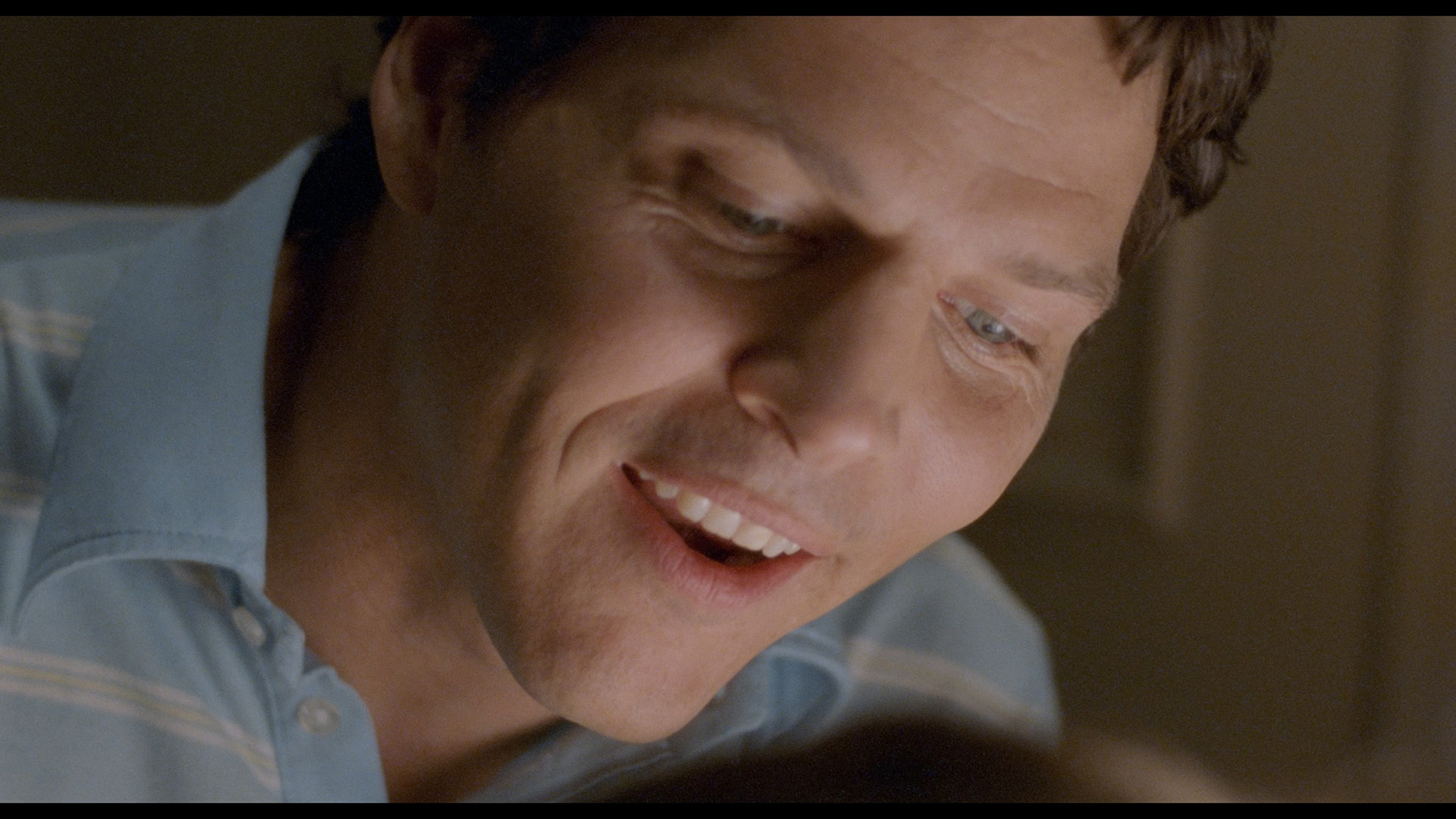 1986 as the excellent miniseries The Deliberate Stranger with Mark Harmon, but here director and co-writer Matthew Bright (Freeway) gets the leeway of a theatrical R rating to go into shocking territory network TV never allowed. Michael Reilly Burke stars as the seemingly average, wholesome, and handsome Ted, whose inner depravity manifests in a string of killings in which he uses disguises or a feigned car breakdown to lure his victims. Thanks to an escaped potential target, Ted catches the attention of law enforcement and goes through the criminal justice system with several more odd twists of fate await. Given a marginal release in theaters, Ted Bundy was a joint effort between Tartan Films (whose early U.K. DVD releases were godsends at the time) and First
1986 as the excellent miniseries The Deliberate Stranger with Mark Harmon, but here director and co-writer Matthew Bright (Freeway) gets the leeway of a theatrical R rating to go into shocking territory network TV never allowed. Michael Reilly Burke stars as the seemingly average, wholesome, and handsome Ted, whose inner depravity manifests in a string of killings in which he uses disguises or a feigned car breakdown to lure his victims. Thanks to an escaped potential target, Ted catches the attention of law enforcement and goes through the criminal justice system with several more odd twists of fate await. Given a marginal release in theaters, Ted Bundy was a joint effort between Tartan Films (whose early U.K. DVD releases were godsends at the time) and First 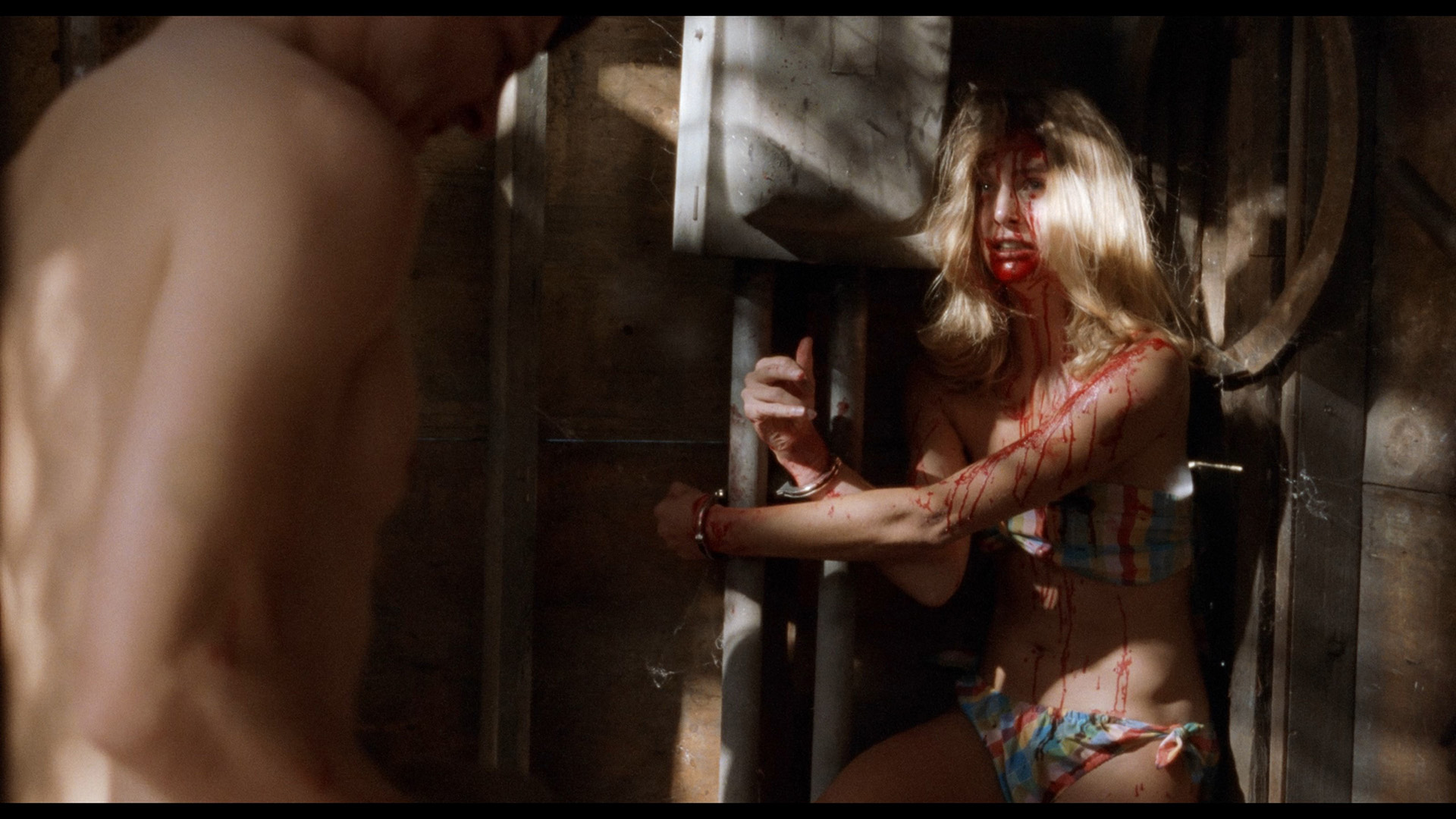 Look, a short-lived indie company who handled it in the U.S. That library fell to parent company Overseas Filmgroup, who in turn brought the film back into circulation via Vinegar Syndrome's VSA region-free Blu-ray release (limited to 5,000 units). The new 2K scan from the 35mm camera negative is a big step up over the old DVD master, to put it mildly, and looks extremely healthy here. DTS-HD MA 5.1 and 2.0 English tracks are provided (both sound fine and make limited ambient surround usage), while Bright appears for a new commentary track with Brad Henderson to chat about casting the lead (after other choices like Keifer Sutherland passed), his own interest in serial killers that propelled his interest in the job, the process of putting the script together in three weeks, and the fictionalizing of the victims. Bright turns up on camera for the new "Burn Bundy Burn" (22m33s) to talk some more about the feature in general terms and address its rather provocative ending, as well as the state of his career at the time in the wake of Freeway. In "Ted Talk" (20m51s), Burke looks back at the project and how he researched the real-life subject as well as how he landed the role (involving a fortuitous game of Scrabble) and the execution of some of the more challenging scenes. "Seeing Evil" (18m59s) features an interview with actress Boti Bliss, who's very good in the film as Bundy's real-life longtime girlfriend, followed by "Scoring Bundy" (16m52s) with composer Kennard Ramsey interviewed via Zoom about his musical approach to the dark material. Production designer Chris Miller also pops in via video conferencing for "Designing Bundy" (18m10s) to cover the look of the film and approach to the film period, and actresses Annalee Autumn, Phoebe Dollar, Alexa Jago, and Deborah Offner turn up in the respective featurettes "A Serious Red Flag" (8m47s), "Highway to Bundy" (10m46s), "Believing Bundy" (11m36s), and "Friend from Work" (13m13s) explaining how they were cast in the film from a variety of backgrounds, what they did to prepare for some arduous fact-based scenes, and what they thought of the finished result and their lead actor. Buy here or here.
Look, a short-lived indie company who handled it in the U.S. That library fell to parent company Overseas Filmgroup, who in turn brought the film back into circulation via Vinegar Syndrome's VSA region-free Blu-ray release (limited to 5,000 units). The new 2K scan from the 35mm camera negative is a big step up over the old DVD master, to put it mildly, and looks extremely healthy here. DTS-HD MA 5.1 and 2.0 English tracks are provided (both sound fine and make limited ambient surround usage), while Bright appears for a new commentary track with Brad Henderson to chat about casting the lead (after other choices like Keifer Sutherland passed), his own interest in serial killers that propelled his interest in the job, the process of putting the script together in three weeks, and the fictionalizing of the victims. Bright turns up on camera for the new "Burn Bundy Burn" (22m33s) to talk some more about the feature in general terms and address its rather provocative ending, as well as the state of his career at the time in the wake of Freeway. In "Ted Talk" (20m51s), Burke looks back at the project and how he researched the real-life subject as well as how he landed the role (involving a fortuitous game of Scrabble) and the execution of some of the more challenging scenes. "Seeing Evil" (18m59s) features an interview with actress Boti Bliss, who's very good in the film as Bundy's real-life longtime girlfriend, followed by "Scoring Bundy" (16m52s) with composer Kennard Ramsey interviewed via Zoom about his musical approach to the dark material. Production designer Chris Miller also pops in via video conferencing for "Designing Bundy" (18m10s) to cover the look of the film and approach to the film period, and actresses Annalee Autumn, Phoebe Dollar, Alexa Jago, and Deborah Offner turn up in the respective featurettes "A Serious Red Flag" (8m47s), "Highway to Bundy" (10m46s), "Believing Bundy" (11m36s), and "Friend from Work" (13m13s) explaining how they were cast in the film from a variety of backgrounds, what they did to prepare for some arduous fact-based scenes, and what they thought of the finished result and their lead actor. Buy here or here.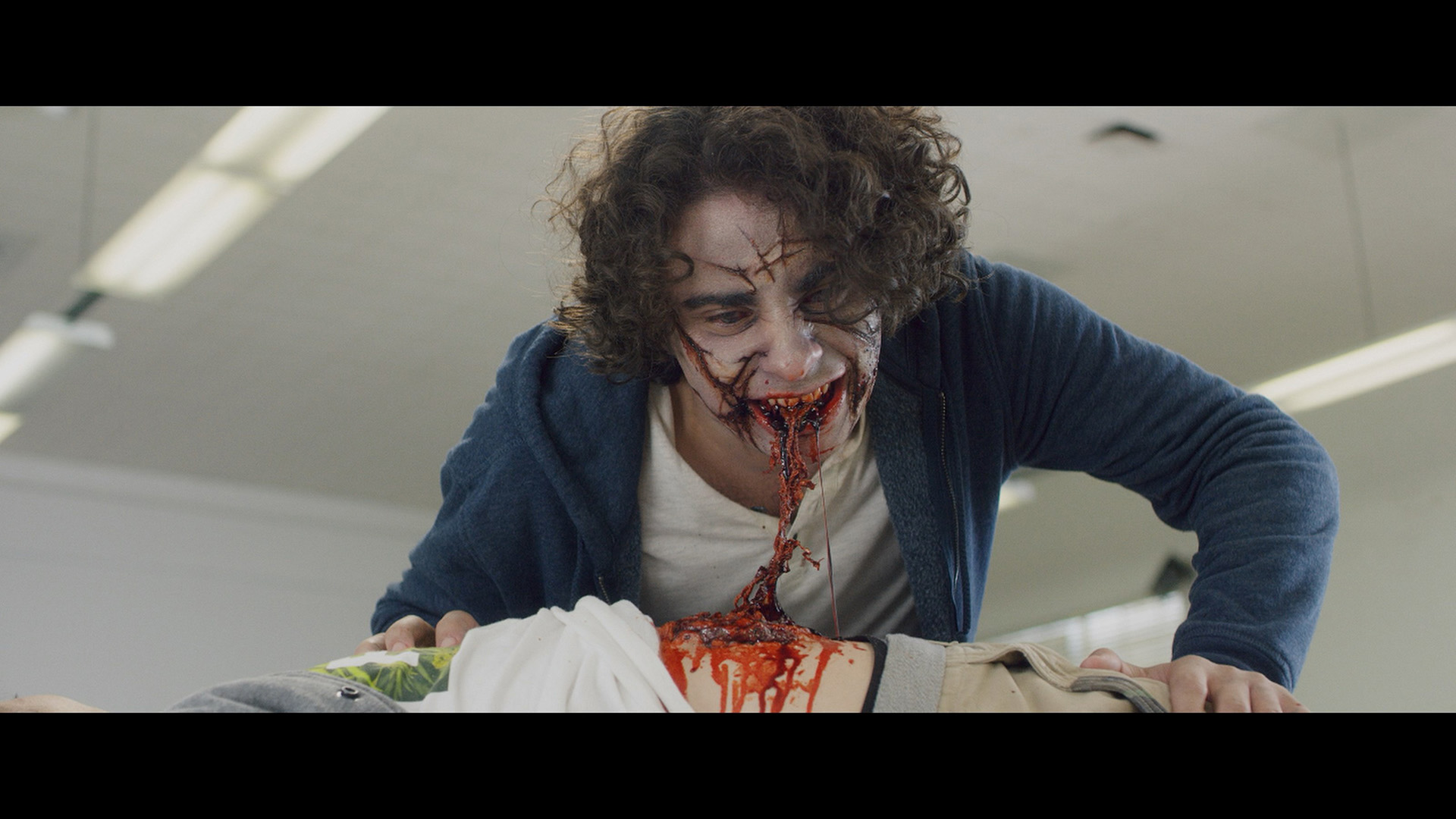 zombie stories, but 2019's Eat Brains Love offers a bit of a tweak to the formula. Directed by Rodman Flender (Idle Hands), it's a lovers on the lam story that starts at a typical high school where unmotivated pothead Jake Stephens (Jake Cannavale) and cheerleader Amanda Blake (Angelique Rivera) suddenly embark on a daytime bloody rampage in the cafeteria when they're infected by a zombie virus. Trying to keep their flesh-eating instincts at bay, they end up on the road in search of a cure while psychic Cassie (Sarah
zombie stories, but 2019's Eat Brains Love offers a bit of a tweak to the formula. Directed by Rodman Flender (Idle Hands), it's a lovers on the lam story that starts at a typical high school where unmotivated pothead Jake Stephens (Jake Cannavale) and cheerleader Amanda Blake (Angelique Rivera) suddenly embark on a daytime bloody rampage in the cafeteria when they're infected by a zombie virus. Trying to keep their flesh-eating instincts at bay, they end up on the road in search of a cure while psychic Cassie (Sarah 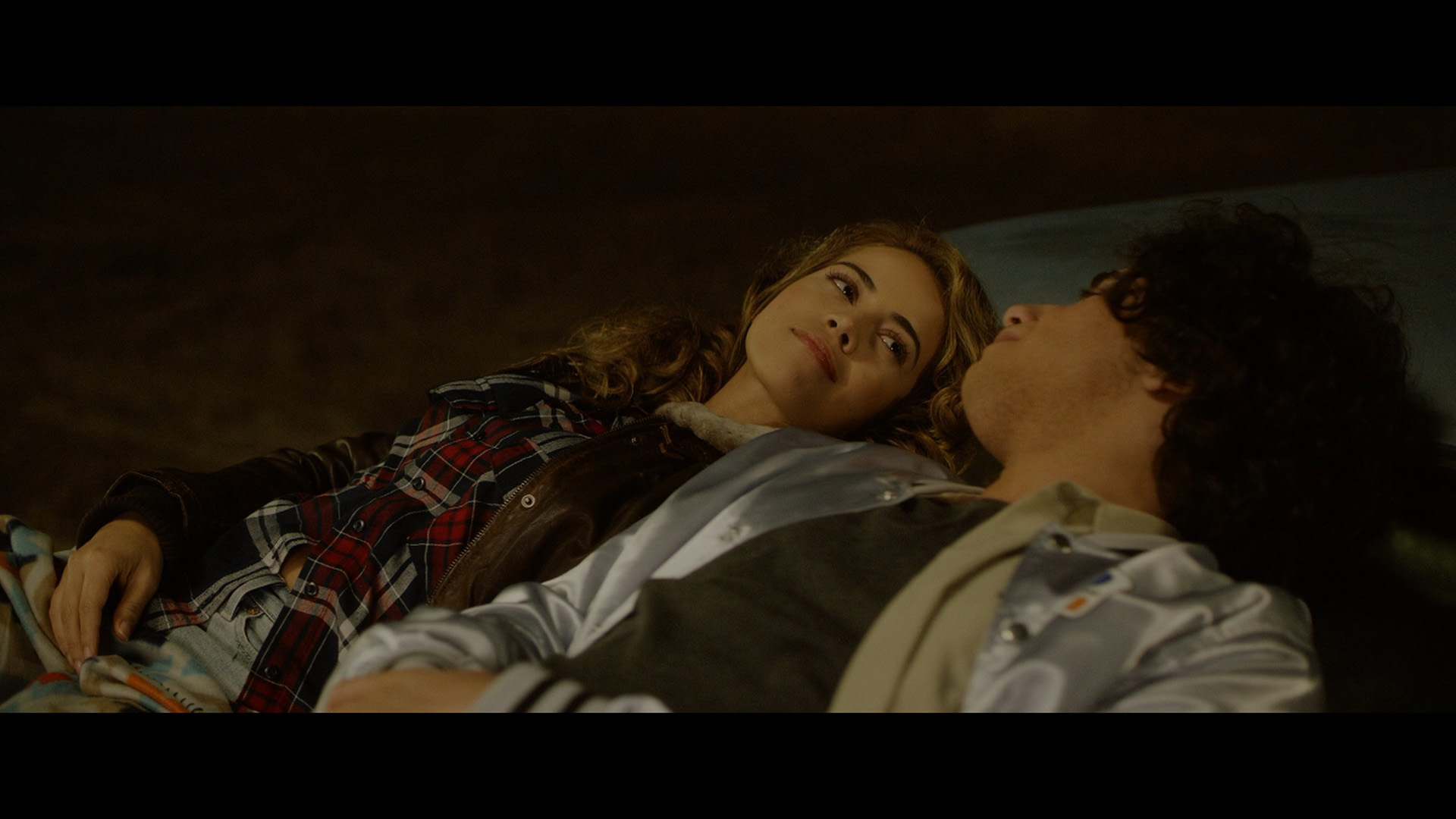 Yarkin) ends up crossing paths with them after doing some "necrotic" investigation at the scene of the crime. In the process they also manage to find a snack or two along the way using the sex offender registry, and law enforcement keeps closing in. Despite the hackneyed title, this is a brisk time killer with a lot more gore than you'd expect including lots of practical limb severing and arterial spraying. Whether the comedy works is going to be a matter of taste, but the evolution of its love triangle offers some changes of pace from the usual formula on the way to a goofy open twist ending. The Region A Blu-ray slipcase edition from Gunpowder & Sky is a lavish one including a pair of Valentine's Day cards and an insert booklet with an essay by Kim Newman about the film's approach to modern zombie conventions. The film itself looks great here as expected, framed at 2.35:1 and featuring a punchy DTS-HD MA 5.1 English track with optional English subs. Flender provides an audio commentary explaining his approach to horror comedy, his discovery of the source novel, and the creative decisions made in conjunction with the cast, while "Herpes of the Undead" (30m39s) features him chatting over Zoom with Rivera and Cannavale about their memories of their shoot from audition to completion as well as their pride in making a "gross" movie that didn't pull any punches. Samm Deighan provides a video essay in "Love Never Dies" (14m16s) exploring the role of romance in tales of the undead, from classic Universal monsters through Val Lewton, Hammer, Michael Jackson's "Thriller," Euro horror, '80s cult classics, and the more recent contributions we have today. Also included are a funny 18s outtake, a 5m50s behind-the-scenes featurette, the trailer, and an 11m1s stills gallery. Buy here or here.
Yarkin) ends up crossing paths with them after doing some "necrotic" investigation at the scene of the crime. In the process they also manage to find a snack or two along the way using the sex offender registry, and law enforcement keeps closing in. Despite the hackneyed title, this is a brisk time killer with a lot more gore than you'd expect including lots of practical limb severing and arterial spraying. Whether the comedy works is going to be a matter of taste, but the evolution of its love triangle offers some changes of pace from the usual formula on the way to a goofy open twist ending. The Region A Blu-ray slipcase edition from Gunpowder & Sky is a lavish one including a pair of Valentine's Day cards and an insert booklet with an essay by Kim Newman about the film's approach to modern zombie conventions. The film itself looks great here as expected, framed at 2.35:1 and featuring a punchy DTS-HD MA 5.1 English track with optional English subs. Flender provides an audio commentary explaining his approach to horror comedy, his discovery of the source novel, and the creative decisions made in conjunction with the cast, while "Herpes of the Undead" (30m39s) features him chatting over Zoom with Rivera and Cannavale about their memories of their shoot from audition to completion as well as their pride in making a "gross" movie that didn't pull any punches. Samm Deighan provides a video essay in "Love Never Dies" (14m16s) exploring the role of romance in tales of the undead, from classic Universal monsters through Val Lewton, Hammer, Michael Jackson's "Thriller," Euro horror, '80s cult classics, and the more recent contributions we have today. Also included are a funny 18s outtake, a 5m50s behind-the-scenes featurette, the trailer, and an 11m1s stills gallery. Buy here or here.PREVIOUS SICK PICKS:
November 7, 2022
May 30, 2022
October 19, 2021
September 6, 2020
January 12, 2020
October 28, 2018
March 24, 2018
May 16, 2017
December 27, 2016
September 9, 2016
May 11, 2016
January 9, 2016
August 17, 2015
May 25, 2015
March 4, 2015
September 25, 2014
March 23, 2014
September 23, 2013
September 2, 2012
May 16, 2012
January 1, 2012
October 23, 2011
September 5, 2011
July 4, 2011
June 5, 2011
March 19, 2011
December 24, 2010
October 25, 2010
October 1, 2010
August 11, 2010
June 15, 2010
November 16, 2009
August 6, 2009
June 11 , 2009
March 19, 2009
October 27, 2008
August 7, 2008
July 25, 2008
May 31, 2008
February 19, 2008
January 8, 2008
October 23, 2007
October 8, 2007
September 29, 2007
![]()